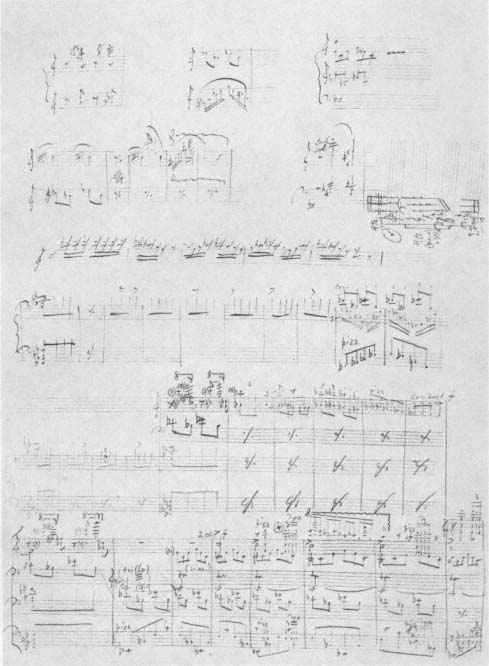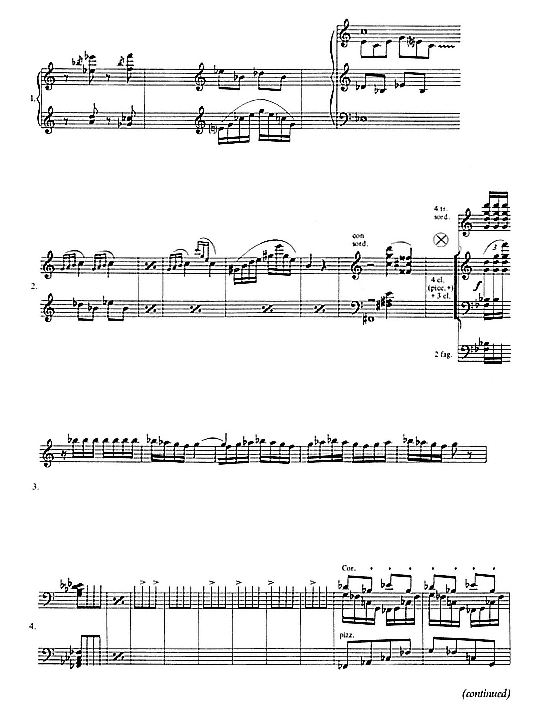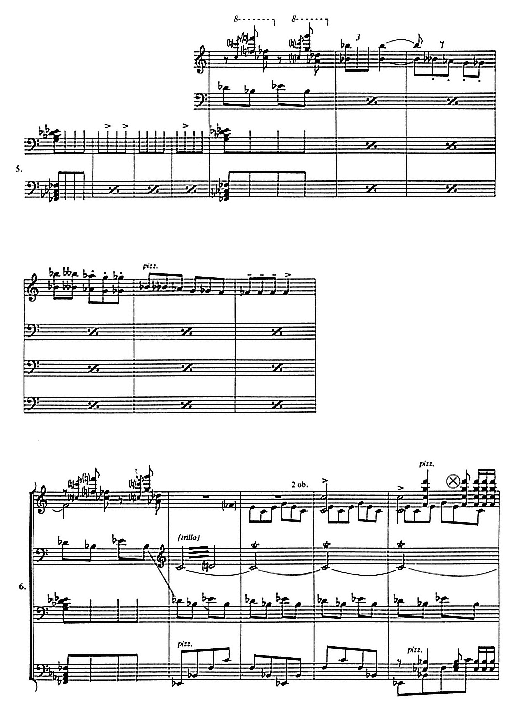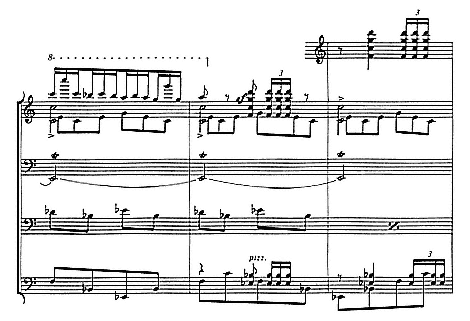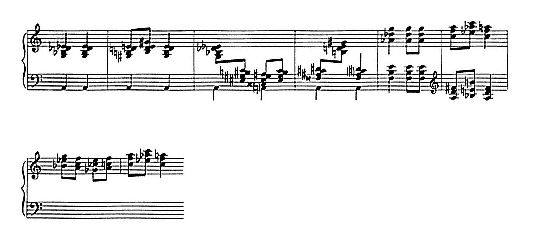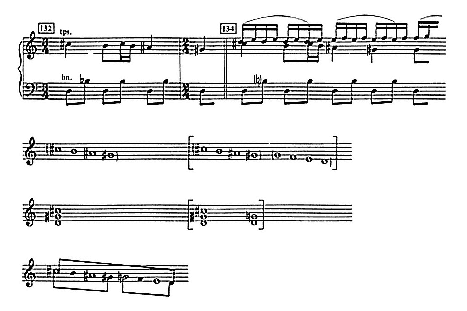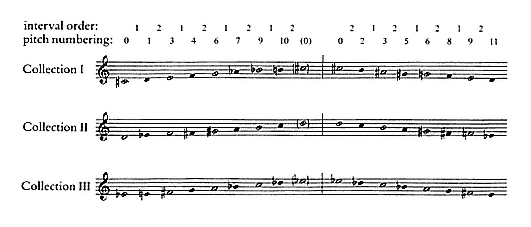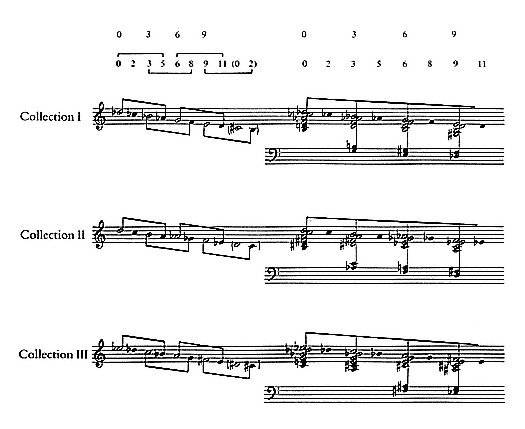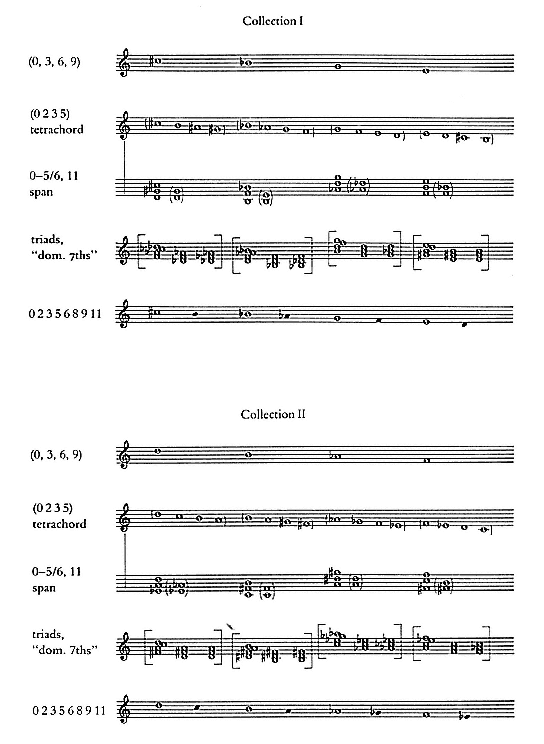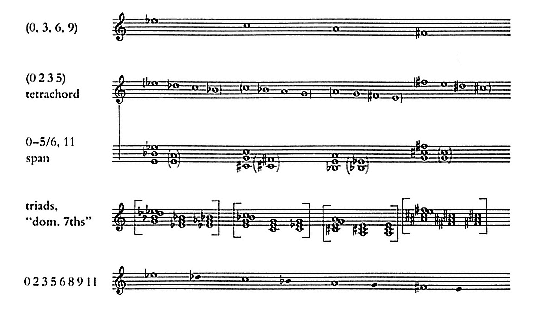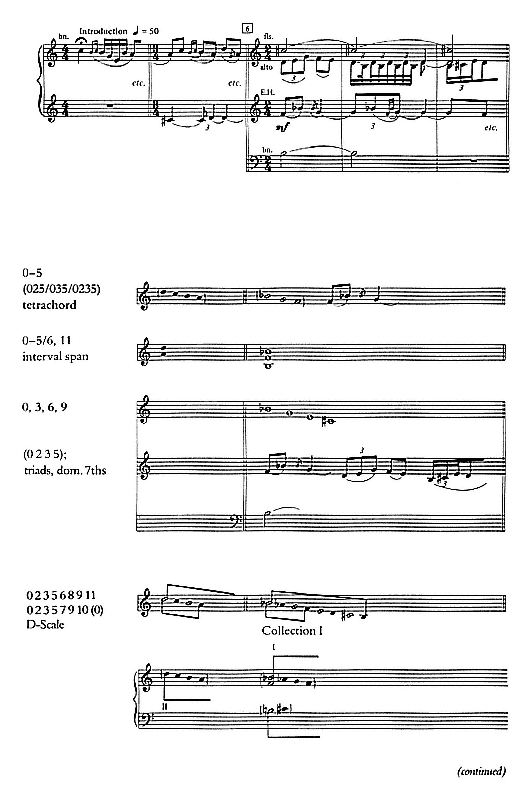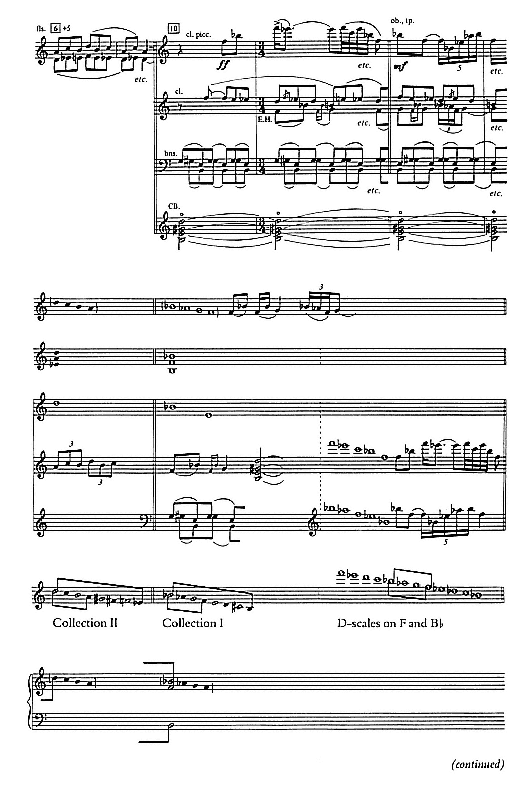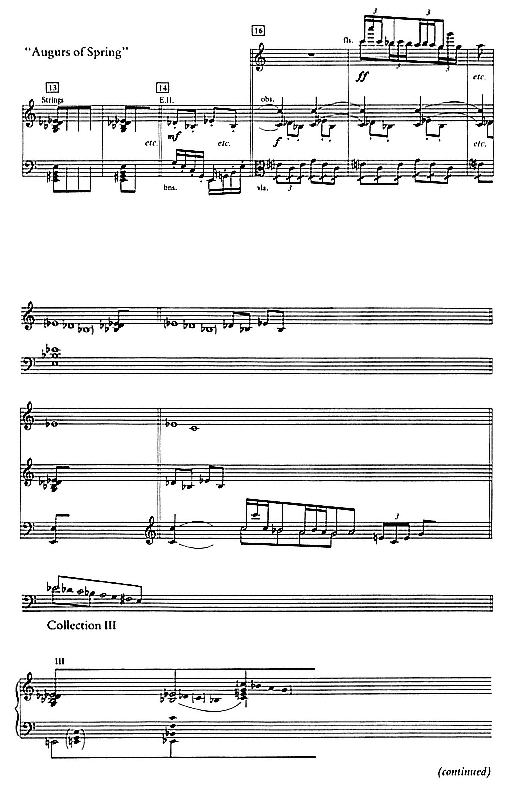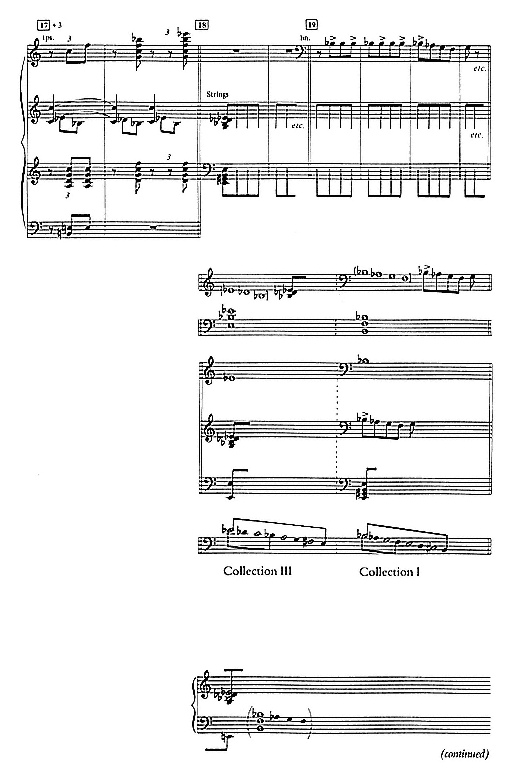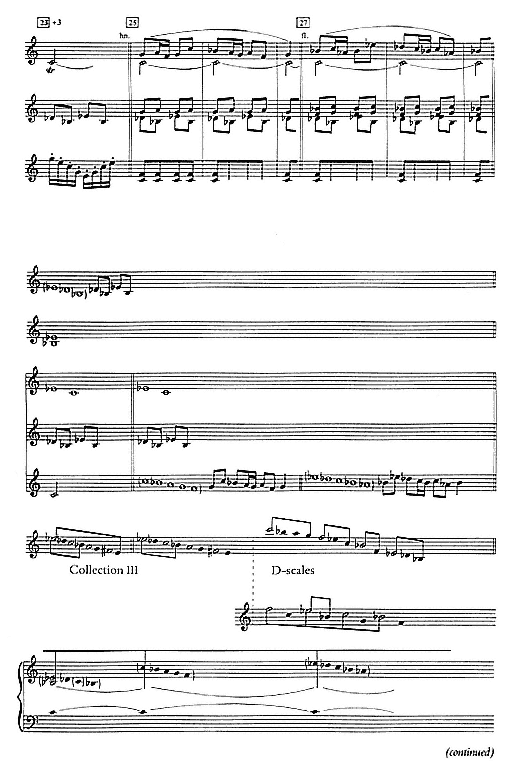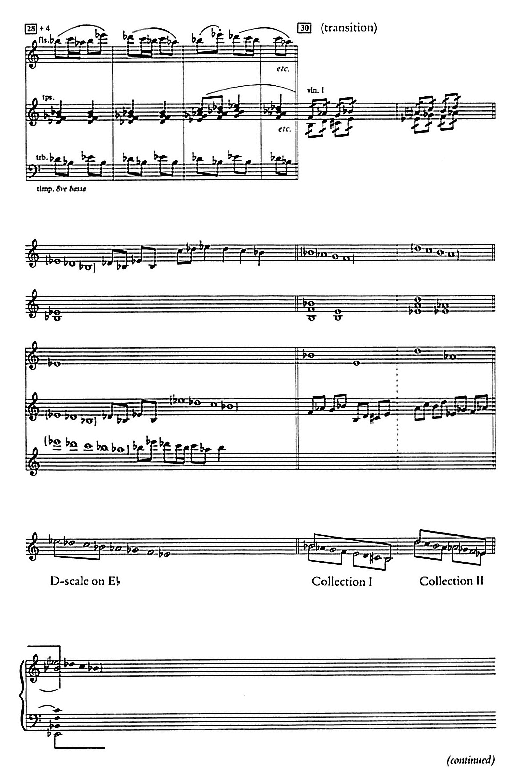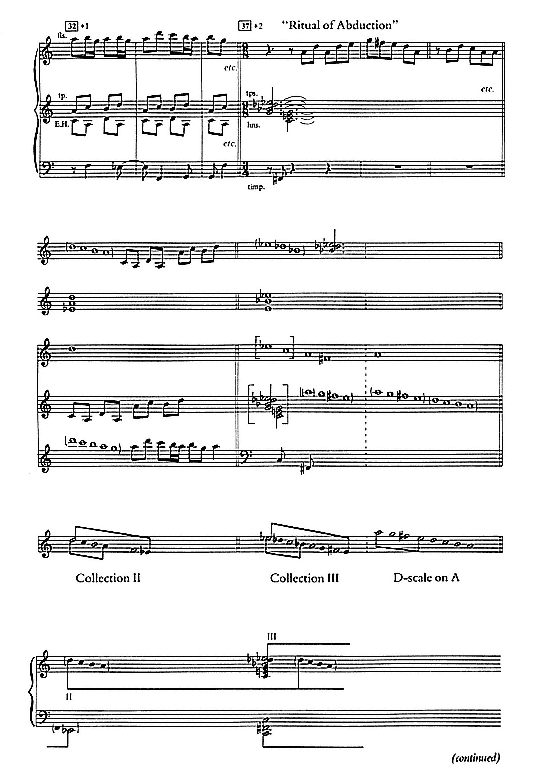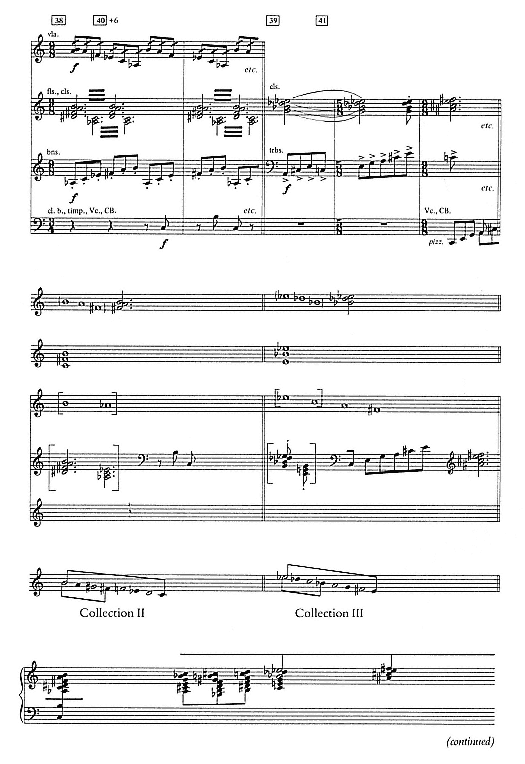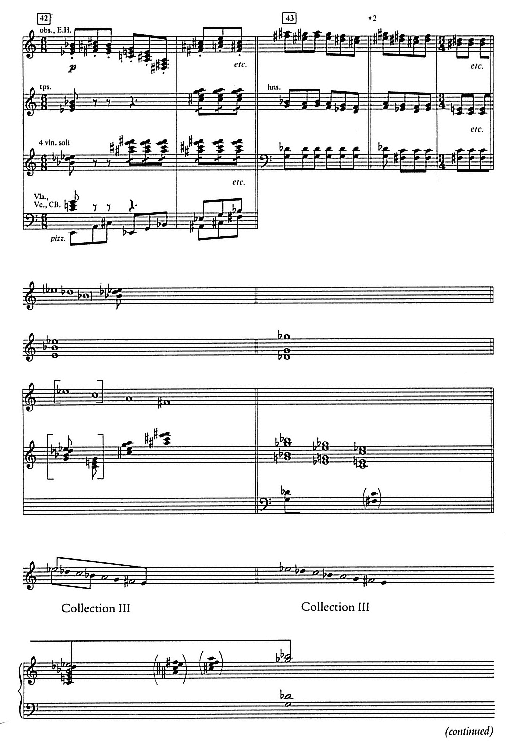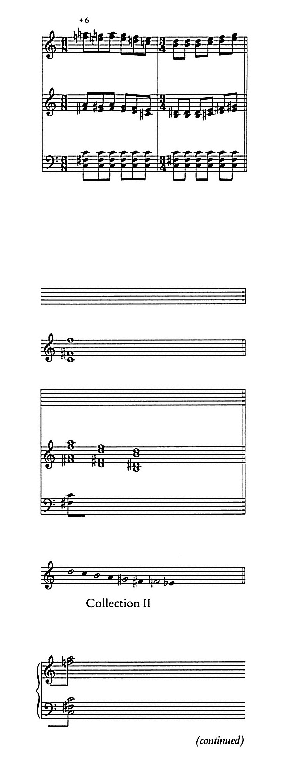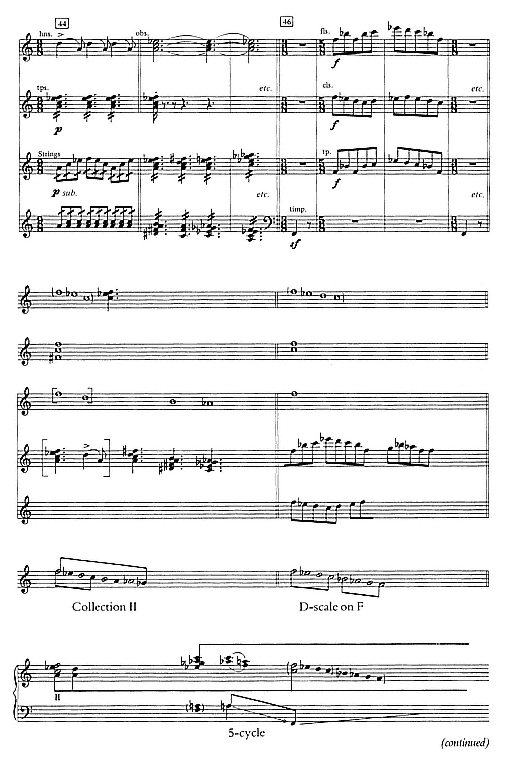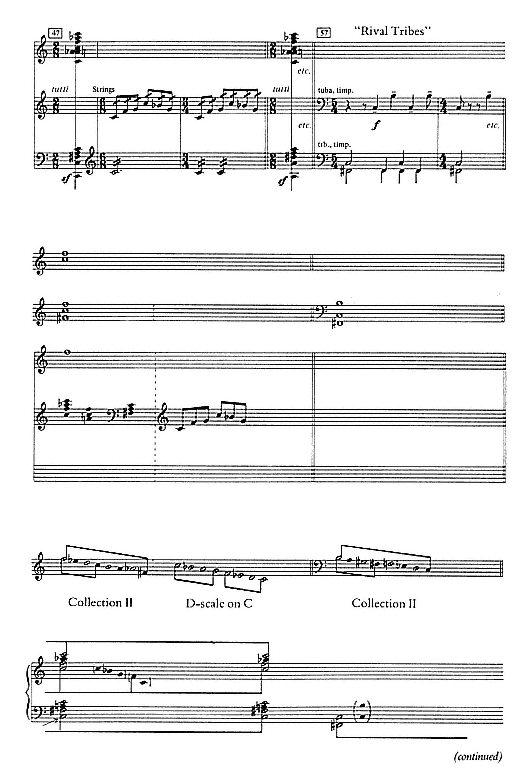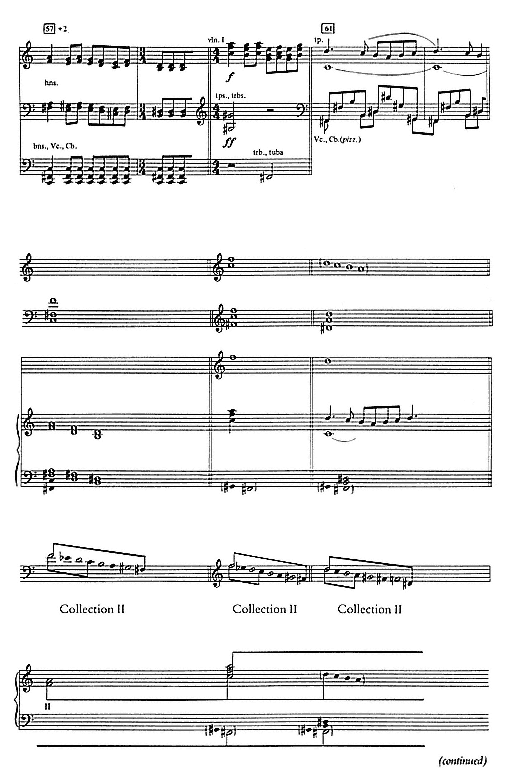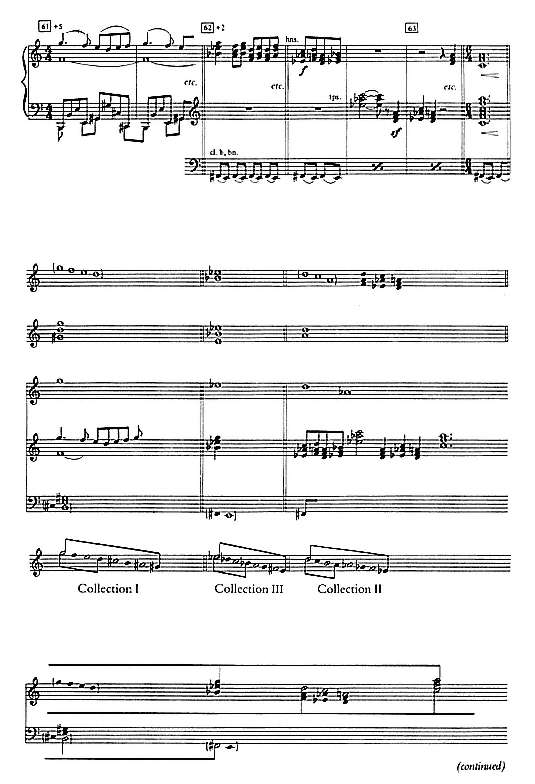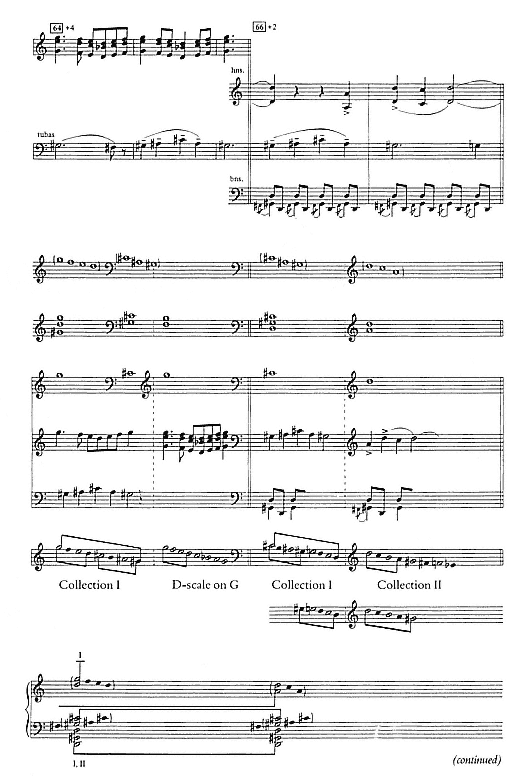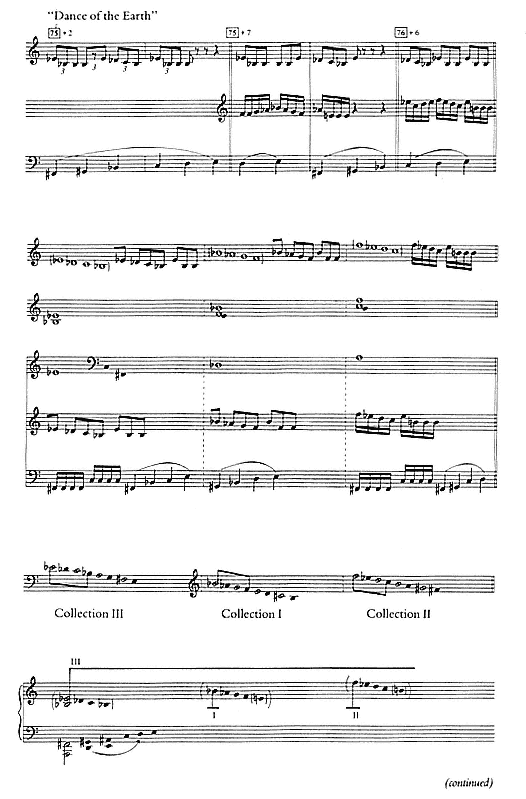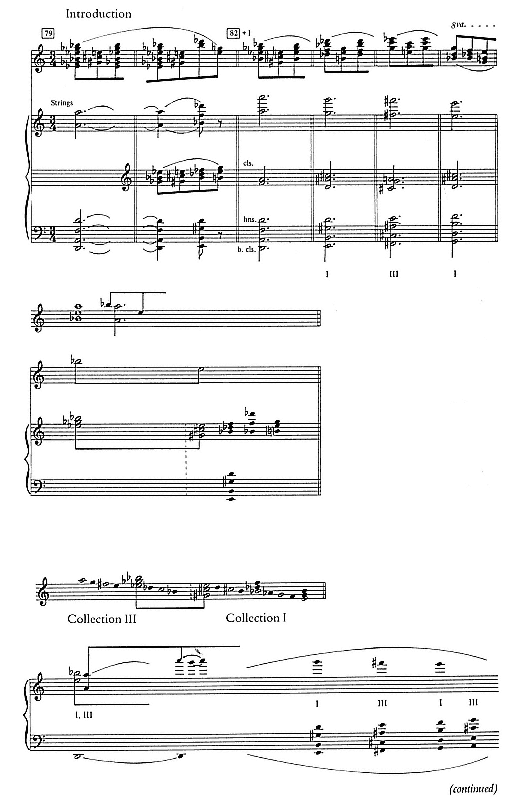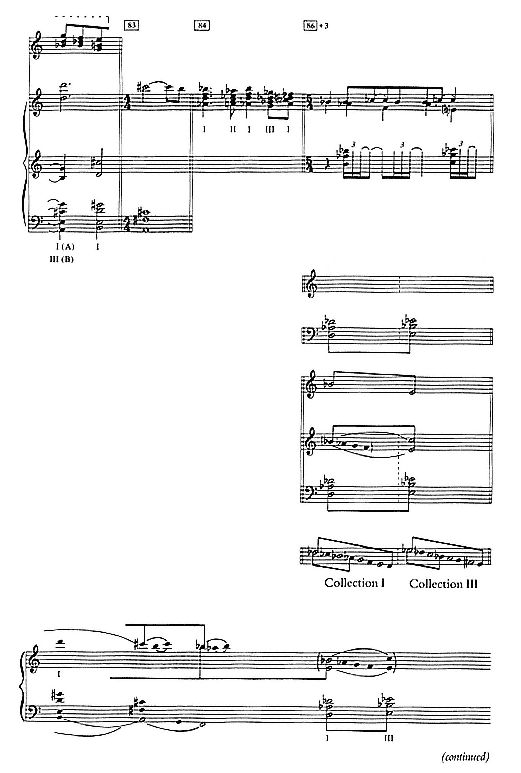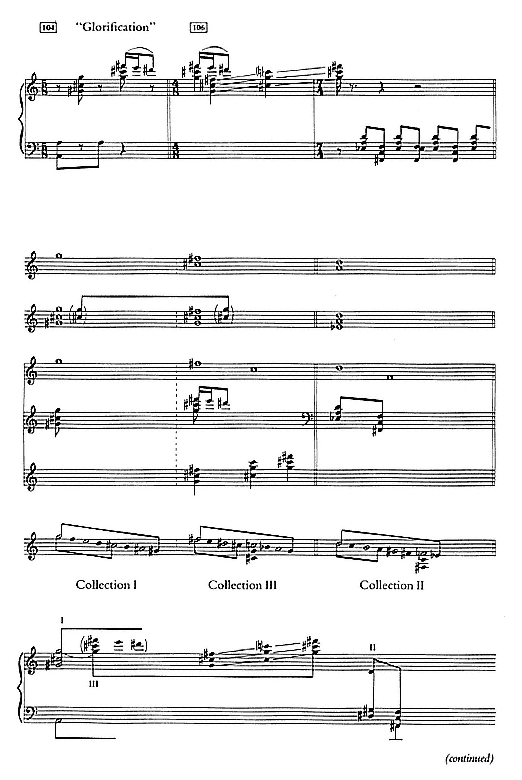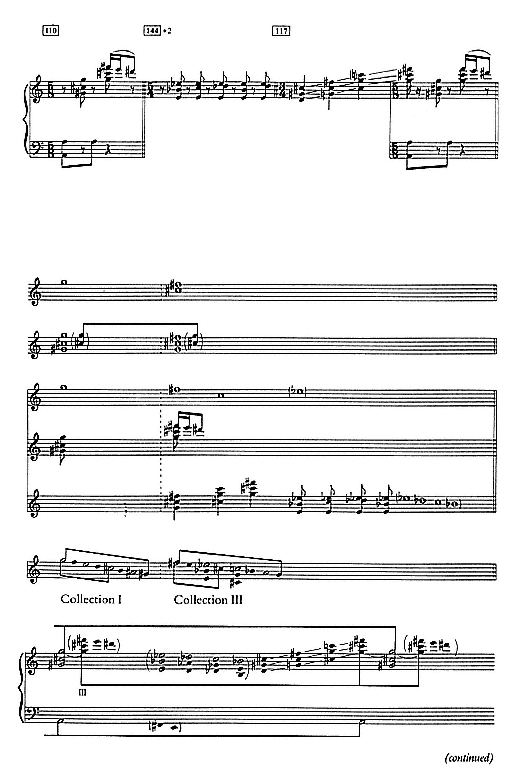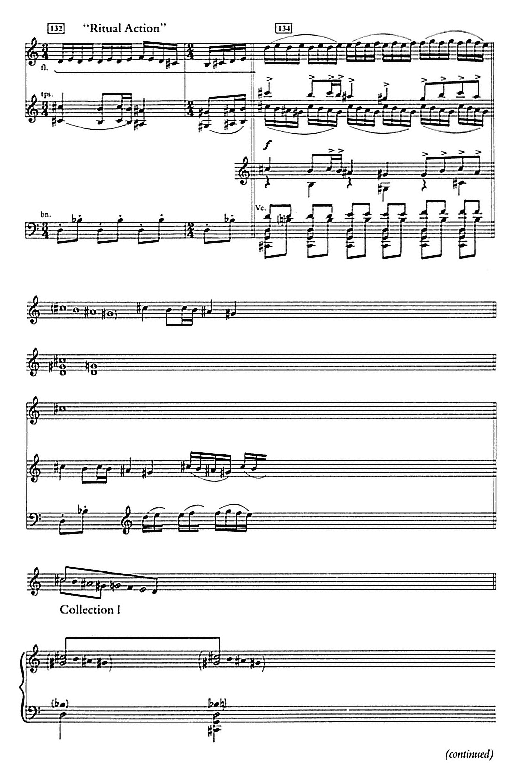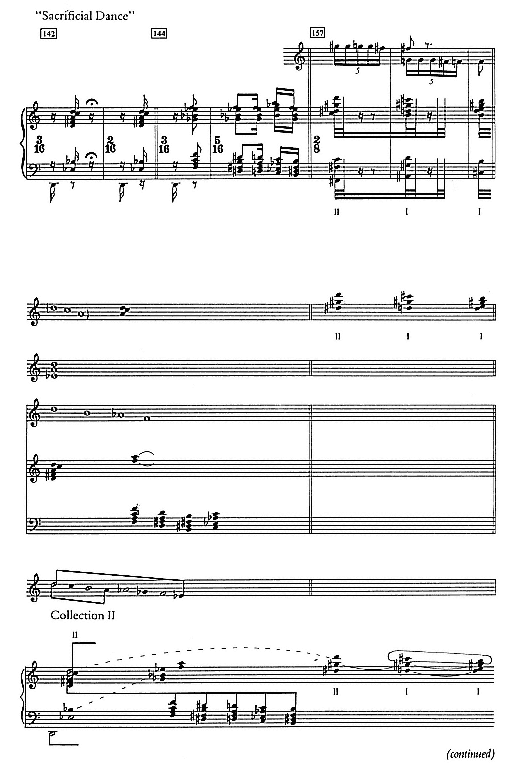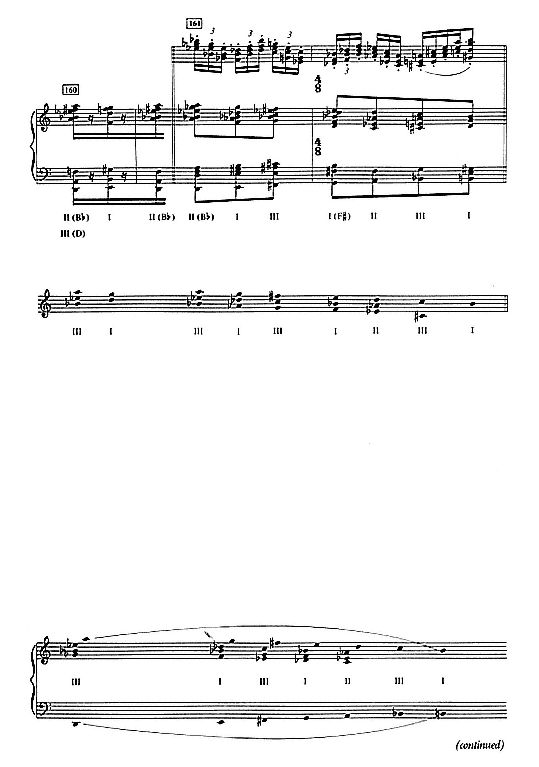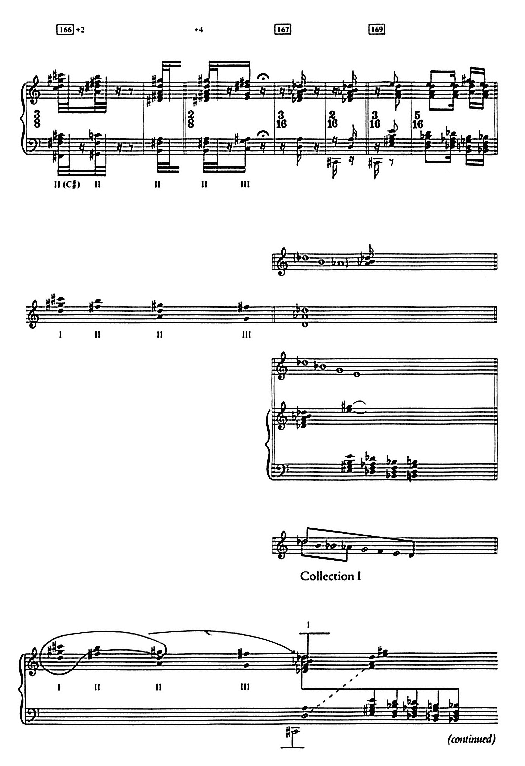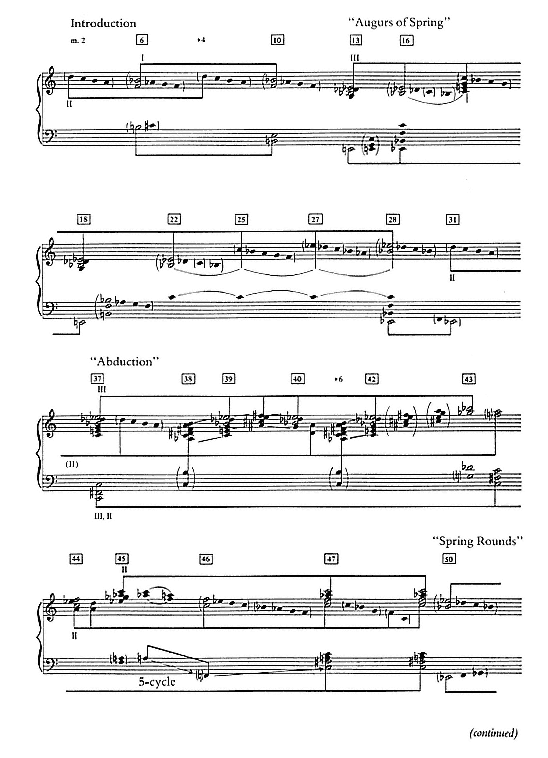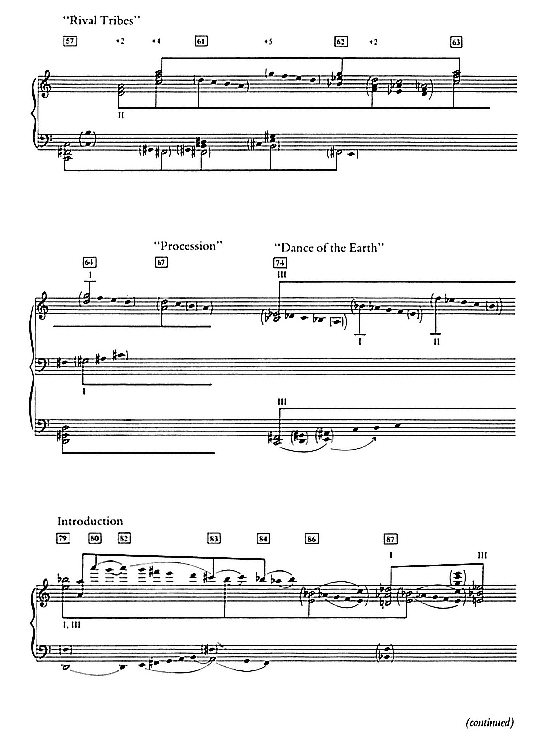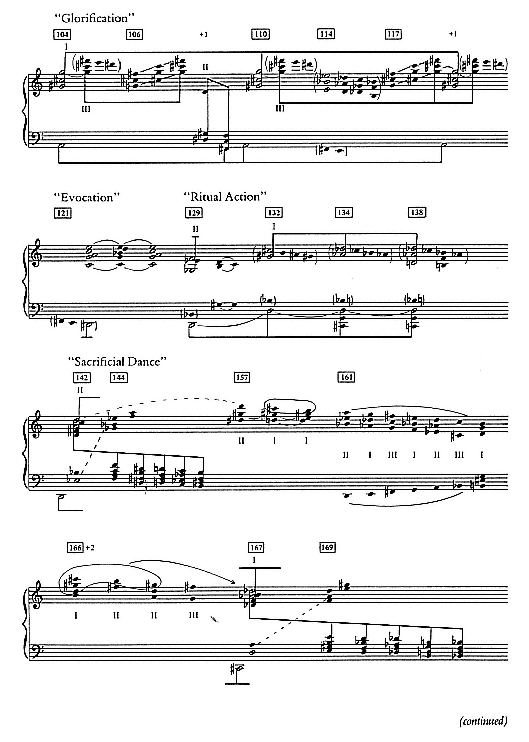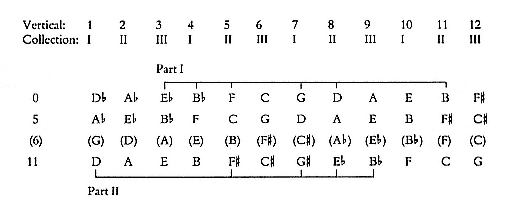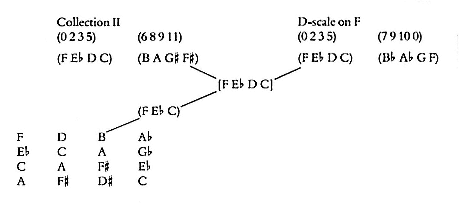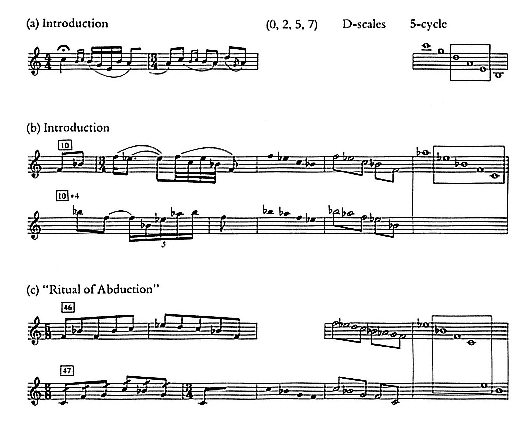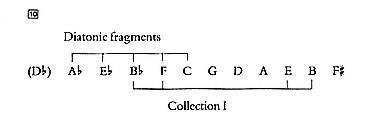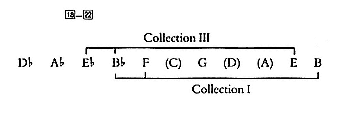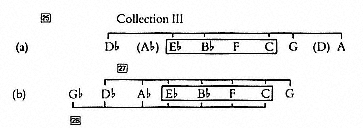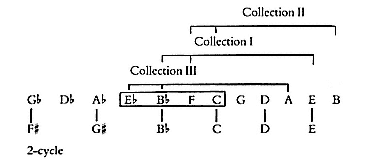6—
Part I:
Pitch Structure
Sketches for the "Augurs of Spring"
Page 3 of the sketchbook of The Rite , reproduced in Figure 3 and transcribed in Example 58, consists of nine entries for the beginning of the "Augurs of Spring." At first glance it would appear that the fifth and sixth lines at the bottom of this page, each with four staves, were composed as a single entry. However, if these lines are read as a continuation of the fourth line directly above (where the "Augurs of Spring" or "motto" chord first appears), then the last three lines constitute, in proper succession, a remarkably accurate account of nos. 13–17 of the score. (Observe that the accentual pattern of the repeated chord, eight measures in length, is fully realized. The score itself extends, at the end of the fourth line, the D ![]() -B
-B ![]() -E
-E ![]() -B
-B ![]() ostinato from two to four measures. The syncopated offbeat figure of the first measure of the last line is eliminated, while the sustained octave C of this line, "2 ob.," becomes a syncopated, upbeat reiteration.) Moreover, inasmuch as pages 4–5 (not shown here) are a further continuation of this sketch extending all the way to the "break" at no. 22, these first three pages of musical notation in turn constitute an accurate account of nos. 13–22. The instrumental cues attached to the last three lines of page 3 are also of considerable interest. The mark "x" at the fifth measure of the last line refers back to the second line's third entry: the latter, inserted sideways and in red ink, was added as an instrumental footnote to the syncopated chord of fifths.
ostinato from two to four measures. The syncopated offbeat figure of the first measure of the last line is eliminated, while the sustained octave C of this line, "2 ob.," becomes a syncopated, upbeat reiteration.) Moreover, inasmuch as pages 4–5 (not shown here) are a further continuation of this sketch extending all the way to the "break" at no. 22, these first three pages of musical notation in turn constitute an accurate account of nos. 13–22. The instrumental cues attached to the last three lines of page 3 are also of considerable interest. The mark "x" at the fifth measure of the last line refers back to the second line's third entry: the latter, inserted sideways and in red ink, was added as an instrumental footnote to the syncopated chord of fifths.
Figure 3:
Early jottings and sketches for the "Augurs of Spring," page 3 of the sketchbook of The Rite.
The Rite of Spring (Le Sacre du Printemps) Sketches , 1911–1913 ,© copyright 1969
Boosey & Hawkes Music Publishers Ltd. Reprinted by permission of Boosey & Hawkes, Inc.
Example 58:
Sketchbook, p. 3 ("Augurs of Spring")
Example 58
(continued)
Example 58
(continued)
In his commentary to the sketchbook, Robert Craft has remarked that such details were unusual at so early a stage in the conception of a Stravinsky work.[1]
Pages 5 and 6 are likewise ostensibly devoted to the "Augurs of Spring." They include a sketch for the "break" at no. 22, entries for the new horn melody at no. 25, and a brief jotting at the bottom of page 5 for the transition or "modulation" at no. 30. Most elaborate, however, is a six-stave sketch at the top of page 6 for the beginning of the first climactic block at nos. 28–30. The latter even includes the melody, introduced by the trumpets at no. 28+4 of the score, that would subsequently serve as the principal motive of the "Spring Rounds." Following its appearance at the top of page 6, the succeeding material of pages 7–9 is in fact given almost entirely to the "Spring Rounds." (Recall that this was the original order of the dances: "Spring Rounds" followed the "Augurs of Spring," while the "Ritual of Abduction" came after the "Rival Tribes" and its succeeding "Procession." According to Craft, the "Spring Rounds" melody was one of Stravinsky's earliest ideas.)[2] The sketches for the "Augurs of Spring" on pages 3–6 underscore the prin-
cipal divisions of this movement as a whole. At the end of the Introduction there is a brief preparation or transition at no. 12. This is followed at nos. 13–22 by Section I, where the motto chord is first introduced, and then at nos. 22–30 by Section II, where two new melodies appear and the motto chord is dropped. Finally, the transition or "modulation" at no. 30 leads to Section III at nos. 31–37, the final climactic block of the "Augurs of Spring."
Somewhat puzzling in relation to the extended sketch are the initial jottings at the top of page 3. Not that the relationship of these entries to the "Augurs of Spring" at nos. 13–22 is in any way obscured. Except for the second line's second entry, where the chords are part of the Introduction's preparatory block at no. 12, all entries refer unambiguously to the extended sketch on pages 3–5. Puzzling, rather, is the immediacy of some of these jottings compared to the surprising gaps evidenced by others. The third notation of the first line is an accurate spelling of m.3 of the last line. On the other hand, the first entry's syncopated offbeat figure is inaccurate, down a whole step from its pitch at m.5 in the fifth line.[3] And the (B ![]() A
A ![]() G F) melody of the third line, while prefacing (C B
G F) melody of the third line, while prefacing (C B ![]() A G) at m.6 in the last line and (B
A G) at m.6 in the last line and (B ![]() A
A ![]() G F) in the bassoons on page 4 (no. 19 in the score), is, in relation to the latter, two octaves too high and in sixteenth-notes.
G F) in the bassoons on page 4 (no. 19 in the score), is, in relation to the latter, two octaves too high and in sixteenth-notes.
All these jottings were undoubtedly composed in preparation for what follows below. Yet the extended sketch, in its overall comprehension and detail, exhibits such a stunning command of the "Augurs of Spring" at nos. 13–22 that the discrepancies revealed by some of these entries are not easily reconciled. Irrespective of whether pages 3–5 do comprise Stravinsky's first notations for the "Augurs of Spring," it is tempting to suppose that the extended sketch had been with the composer for some time prior to actual notation and that the prefatory jottings on page 3 were entered as "soundings" with a preexistent view toward the more precise plan of action detailed below.
Noteworthy in this respect are the sketchbook's initial entries for the "Glorification of the Chosen One" on pages 52, 59, 61, and 66–67 and those for the "Sacrificial Dance" on pages 84–85. These, as noted in Chapter 2, reveal a similarly developed character. And the role of the piano in Stravinsky's inventive processes, early on as an aid in improvisation and then in a constant "testing" of the ear, cannot sufficiently be stressed. Notice, for example, the easy right-hand-left-hand "lie" of the motto chord itself, which underscores the chord's compound nature, its triadically sealed top and bottom "halves." Here, too, then, the pianistic element is most conspicuous in those entries which are at the outset highly developed, suggesting the early, improvisational origin of this material. In contrast, the sketches for the Introduction to Part II and the "Mystic Circles of the Young Girls," material that lacks such a pianistic orientation, are among the most extensive and seemingly arduous in the sketchbook.
Indeed, when Stravinsky first examined the sketchbook after a period of some fifty years, he cited as his first notation on page 3 not the initial jottings but the motto chord at the fourth line (along, presumably, with its rhythmic pattern, eight measures in length).[4] And the foundational status of this chord has long been taken for granted. Earlier in the century, in his revisionist interview with Comoedia , Stravinsky claimed that the "embryo" of The Rite , "strong and brutal" in character, had been conceived while completing The Firebird in the spring of 1910.[5] André Schaeffner's biography, where much of the information is known to have come from the composer himself, acknowledged the chord as "the first musical idea," composed, however, during the summer of 1911.[6] Craft gave a similar account: the composer continued to single out the "focal chord" of The Rite , the E ![]() dominant seventh superimposed over (E G
dominant seventh superimposed over (E G ![]() B), as his initial idea.[7] (Craft in turn analyzed the top half of the chord, the dominant seventh itself, as "a root idea of the entire piece.") Indeed, in an added reflection that points to both its keyboard, improvisational origin and its apparent isolation from whatever else might at the time have been engaging the composer musically, Stravinsky recalled that he had initially been unable to explain or justify the chord's construction, but that his ear had nonetheless "accepted it with joy."[8] (The chord's immediate "justification" is readily apparent on page 3, in its relationship to the D
B), as his initial idea.[7] (Craft in turn analyzed the top half of the chord, the dominant seventh itself, as "a root idea of the entire piece.") Indeed, in an added reflection that points to both its keyboard, improvisational origin and its apparent isolation from whatever else might at the time have been engaging the composer musically, Stravinsky recalled that he had initially been unable to explain or justify the chord's construction, but that his ear had nonetheless "accepted it with joy."[8] (The chord's immediate "justification" is readily apparent on page 3, in its relationship to the D ![]() -B
-B ![]() -E
-E ![]() -B
-B ![]() ostinato and the (E G
ostinato and the (E G ![]() B) arpeggio of the second line, a relationship which is in turn stressed registrally at the end of the fourth line.) But Craft later reversed himself. Citing his intimate acquaintance with the composer's working habits, he concluded in his commentary to the sketchbook that there was no reason to doubt the left-to-right and top-to-bottom "chronological order" of page 3: the melodic conception of the chord, the D
B) arpeggio of the second line, a relationship which is in turn stressed registrally at the end of the fourth line.) But Craft later reversed himself. Citing his intimate acquaintance with the composer's working habits, he concluded in his commentary to the sketchbook that there was no reason to doubt the left-to-right and top-to-bottom "chronological order" of page 3: the melodic conception of the chord, the D ![]() -B
-B ![]() -E
-E ![]() -B
-B ![]() ostinato and its (E G
ostinato and its (E G ![]() B) accompaniment in the initial jottings, had come first, while the chord at the fourth line had come as a subsequent verticalization of this conception. He discussed the matter with the composer, who later agreed that this was "probable."[9]
B) accompaniment in the initial jottings, had come first, while the chord at the fourth line had come as a subsequent verticalization of this conception. He discussed the matter with the composer, who later agreed that this was "probable."[9]
At issue, of course, is not the authenticity of a left-to-right and top-to-bottom reading of page 3 (with the jottings preceding the fourth line), but whether this "chronological order" can be taken as representing the very earliest invention.
To recapitulate here for a moment: it is almost universally agreed that, following performances of Petrushka in Paris, Stravinsky began to compose his sketches for the "Augurs of Spring," "Spring Rounds," and possibly even the "Ritual of the Rival Tribes" during the summer of 1911 at Ustilug, Russia. He may have begun
Example 59
in July, either before or after his visit with Nicolas Roerich, at which time the scenario and the titles of the dances were decided upon. Little could have been accomplished in August. The composer made trips to Karlsbad to settle the commission with Diaghilev, to Warsaw and Lugano to meet with Alexandre Benois, and finally to Berlin to visit his publisher, Russischer Musik Verlag, on matters pertaining to Petrushka . In fact, Craft estimates that the initial notations for the "Augurs of Spring" were entered after the composer's return from Berlin, on or around September 2.[10]
In a letter to Roerich dated September 26, 1911, Stravinsky informed his collaborator of his new address in Clarens, Switzerland, explaining that he had already begun to compose a dance, his description of which fits the "Augurs" movement.[11] Yet it is entirely possible—indeed probable, as suggested—that these sketches were preceded not only by considerable improvisation (both at and away from the piano), but by additional sketch material as well. The existence of sketches as much as a year earlier is confirmed by two letters from Stravinsky to Roerich dated July 2, 1910, and August 9, 1910.[12] And Craft has published what he believes to be the earliest extant sketch for The Rite : pre-dating the sketchbook, and given here as Example 59, it shows an E ![]() dominant seventh superimposed over an A (rather than an E), and with general contours and rhythms that anticipate sections from both the "Ritual of the Rival Tribes" and the "Sacrificial Dance."[13] In
dominant seventh superimposed over an A (rather than an E), and with general contours and rhythms that anticipate sections from both the "Ritual of the Rival Tribes" and the "Sacrificial Dance."[13] In
other words, the order of the entries on page 3, even if authentic, in no way discounts the possibility that the motto chord of the fourth line might indeed have been the composer's first idea.
But how significant is the which-came-first argument? Can it matter all that much whether, as Craft now claims, the motto chord of the fourth line was derived from the D ![]() -B
-B ![]() -E
-E ![]() -B
-B ![]() ostinato and its (E G
ostinato and its (E G ![]() B) chordal affiliation in the initial jottings, or whether, as has generally been assumed, the chord came first and spawned its melodic conception? In the extended sketch for nos. 13–22, as in the score itself at no. 13, the chord appears first, while the ostinato and its (E G
B) chordal affiliation in the initial jottings, or whether, as has generally been assumed, the chord came first and spawned its melodic conception? In the extended sketch for nos. 13–22, as in the score itself at no. 13, the chord appears first, while the ostinato and its (E G ![]() B) accompaniment detach themselves from this construction eight measures later. On the other hand, if the preparation at no. 12 is taken into account, then the ostinato is first heard, pizzicato in the second violins, as a melodic component in anticipation of the chord at no. 13. The real miracle, however, is that the impact of the chord, the shock of its hammer-like, percussive action, is so entirely dependent on the "loose," contrapuntal network of the "awakening of nature" in the Introduction and that this latter should not have been composed until after the first three dances, and possibly even after the whole of Part I, as Stravinsky later maintained.[14]
B) accompaniment detach themselves from this construction eight measures later. On the other hand, if the preparation at no. 12 is taken into account, then the ostinato is first heard, pizzicato in the second violins, as a melodic component in anticipation of the chord at no. 13. The real miracle, however, is that the impact of the chord, the shock of its hammer-like, percussive action, is so entirely dependent on the "loose," contrapuntal network of the "awakening of nature" in the Introduction and that this latter should not have been composed until after the first three dances, and possibly even after the whole of Part I, as Stravinsky later maintained.[14]
Clearly the essentials here are: (1) that the notations for the "Augurs of Spring" on pages 3 and 4 of the sketchbook, whether in their most original form or not, probably represent the composer's earliest ideas for The Rite ; and (2) that these ideas, forming the very cornerstone of The Rite , introduce vertical and linear arrangements that are of paramount concern not only to a consideration of the "Augurs of Spring" but of succeeding movements as well. Regardless of which came first, the chord or its melodic conception, these arrangements are central to our analytic-theoretical perspective.
1. The three pitches of the D ![]() -B
-B ![]() -E
-E ![]() -B
-B ![]() ostinato constitute, respectively, the dominant seventh, fifth, and root of the E
ostinato constitute, respectively, the dominant seventh, fifth, and root of the E ![]() dominant-seventh chord, the top half of the motto chord. This relationship is sustained registrally in the concluding two measures of the fourth line.
dominant-seventh chord, the top half of the motto chord. This relationship is sustained registrally in the concluding two measures of the fourth line.
2. The disengagement from the motto chord of E ![]() , D
, D ![]() , and B
, and B ![]() as an ostinato and of (E G
as an ostinato and of (E G ![]() B) as its accompaniment underscores the compound nature of the chord; that is, the superimposition of the E
B) as its accompaniment underscores the compound nature of the chord; that is, the superimposition of the E ![]() dominant seventh and of the D
dominant seventh and of the D ![]() -B
-B ![]() -E
-E ![]() -B
-B ![]() ostinato over (E G
ostinato over (E G ![]() B).
B).
3. Vertical or linear in conception, the superimposed quality of the configuration points in turn to the essential triadic makeup of the harmony in these initial pages.
4. Apart from arpeggios, melody is represented most prominently by the (B ![]() A
A ![]() G F) tetrachord of the third line and by (C B
G F) tetrachord of the third line and by (C B ![]() A G) at m. 5 in the last line. Encountered in Chapter 5, this is the minor or Dorian tetrachord with in-
A G) at m. 5 in the last line. Encountered in Chapter 5, this is the minor or Dorian tetrachord with in-
terval order 2-1-2 (whole step-half step-whole step) and with a pitch numbering of (0 2 3 5). The D ![]() -B
-B ![]() -E
-E ![]() -B
-B ![]() ostinato may in this connection be regarded as an incomplete (E
ostinato may in this connection be regarded as an incomplete (E ![]() D
D ![]() (C) B
(C) B ![]() ) tetrachord.
) tetrachord.
5. The (C E G) triad, substituting occasionally for (E G ![]() B) in the accompaniment, forms, in combination with the E
B) in the accompaniment, forms, in combination with the E ![]() dominant seventh or the D
dominant seventh or the D ![]() —B
—B ![]() —E
—E ![]() —B
—B ![]() ostinato above, another prominent configuration in The Rite , especially in the "Ritual of Abduction" and later in the Introduction to Part II at nos. 86–89.
ostinato above, another prominent configuration in The Rite , especially in the "Ritual of Abduction" and later in the Introduction to Part II at nos. 86–89.
6. The outer pitches of the motto chord, E ![]() and E reading down (the roots of the two triadic subcomplexes), define a 0–11 or major-seventh vertical span that is sustained statically and very nearly continuously throughout The Rite .
and E reading down (the roots of the two triadic subcomplexes), define a 0–11 or major-seventh vertical span that is sustained statically and very nearly continuously throughout The Rite .
And so pages 3 and 4 of the sketchbook introduce groupings or arrangements central to the "Augurs" movement and to the work as a whole: the vocabulary of The Rite consists in large part of 0–2 whole-step reiterations, (0 2 3 5) tetrachords, major and minor triads, dominant-seventh chords, and 0–11 or major-seventh vertical interval spans. (Again, as in earlier chapters, conventional terminology is employed for purposes of identification, with no intention of invoking tonally functional relations.) And although, given the reputation of this piece as one of considerable complexity, this reduction might seem a bit fanciful, we can narrow the scheme somewhat. The (0 2 3 5) tetrachord, as the principal melodic fragment not only of The Rite but of Stravinsky's "Russian" period generally, surfaces by way of all manner of reiterating, folkish tunes. As such, it is invariably articulated in the tightest or closest arrangement, confined to the interval of 5, the fourth (without interval complementation, in other words). It may nonetheless be either (0 2 5) or (0 3 5), incomplete, as noted already, with the D ![]() -B
-B ![]() -E
-E ![]() -B
-B ![]() ostinato or (E
ostinato or (E ![]() D
D ![]() (C) B
(C) B ![]() ) unit, which lacks the C, pitch number 3 reading down.
) unit, which lacks the C, pitch number 3 reading down.
The triads and dominant sevenths also assume a characteristic disposition: as with the (0 2 3 5) tetrachord, the tight or close arrangement. This is not always the case but is customary, especially in the treble registers. The typical dominant-seventh placement is exemplified by the top half of the motto chord: closed position, "first inversion." Starting with the chord's E ![]() dominant seventh at no. 13, Example 60 traces continued reference to this disposition throughout The Rite . All these fixed arrangements are bound to be of consequence to a local or global reading of The Rite , a matter to which we shall therefore be returning for further comment. But note, for the moment, how closely this tight articulation is linked to the melodic repetition and then to the rhythmic-metric implications of this repetition. In other words, given the superimposed, layered structure of The Rite , a construction in which fragments, fixed registrally and instrumentally, repeat according to the two rhythmic types outlined in preceding chapters, the tight or limited fragmental compass becomes inevitable.
dominant seventh at no. 13, Example 60 traces continued reference to this disposition throughout The Rite . All these fixed arrangements are bound to be of consequence to a local or global reading of The Rite , a matter to which we shall therefore be returning for further comment. But note, for the moment, how closely this tight articulation is linked to the melodic repetition and then to the rhythmic-metric implications of this repetition. In other words, given the superimposed, layered structure of The Rite , a construction in which fragments, fixed registrally and instrumentally, repeat according to the two rhythmic types outlined in preceding chapters, the tight or limited fragmental compass becomes inevitable.
By contrast, the 0–11 vertical span is rarely melodic in character (fragmental or
linear), but defines, harmonically or vertically, the span between pitches of unmistakable priority among superimposed, reiterating fragments or chords. Thus, as noted above, the E ![]() -E span of the motto chord and its subsequent melodic formulation; or, in Example 60, the subsequent pitch realizations of this span further along in Parts I and II. In Example 61 from the "Ritual Action of the Ancestors" in Part II, the (0 2 3 5) tetrachord, (C
-E span of the motto chord and its subsequent melodic formulation; or, in Example 60, the subsequent pitch realizations of this span further along in Parts I and II. In Example 61 from the "Ritual Action of the Ancestors" in Part II, the (0 2 3 5) tetrachord, (C ![]() B A
B A ![]() G
G ![]() ) here in the trumpets, is superimposed over a D-B
) here in the trumpets, is superimposed over a D-B ![]() ostinato in the bassoon. Reading down, the 0–11 span is therefore C
ostinato in the bassoon. Reading down, the 0–11 span is therefore C ![]() —D as defined between the C
—D as defined between the C ![]() of the upper (C
of the upper (C ![]() B A
B A ![]() G
G ![]() ) tetrachord and the low D of the D-B
) tetrachord and the low D of the D-B ![]() unit. Similarly, in Example 54 in Chapter 5, from the "Ritual of the Rival Tribes," a reiterating (G F E D) tetrachordal fragment is superimposed over a lower G
unit. Similarly, in Example 54 in Chapter 5, from the "Ritual of the Rival Tribes," a reiterating (G F E D) tetrachordal fragment is superimposed over a lower G ![]() ; the 0–11 span is G-G
; the 0–11 span is G-G ![]() , reading down again. And starting with the
, reading down again. And starting with the
Example 60
Example 61:
"Ritual Action of the Ancestors"
motto chord at no. 13, note the metric accentuation of the 0–11 span in these illustrations, an accentuation that typifies its articulation throughout The Rite , rendering it highly conspicuous from one block or movement to the next.
The Octatonic Pitch Collection
Listed above are thus the principal articulative units, the common denominators, so to speak, often with dispositions of marked character. What may in turn be judged the referential glue of this vocabulary, what binds within and between blocks and sections, is very often the octatonic pitch collection. More precisely, the referential character of this vocabulary is very often determined by its confinement, for periods of significant duration, to one of the three octatonic collections of distinguishable content.
As was defined in Chapter 5, the octatonic collection is a set of eight distinct pitch classes that, arranged in scale formation, yields the interval ordering of alternating 1s and 2s (half and whole steps). Such an arrangement obviously yields only two possible interval orderings or scales, the first of these with its second scale degree at the interval of 1 from its first (a 1-2, half step-whole step ordering), the second with its second scale degree at the interval of 2 from its first (a 2-1, whole step-half step ordering). These are shown in Example 62, with the 1-2 ordering and consequent (0 1 3 4 6 7 9 10 (0)) pitch numbering on the left side, the reverse 2-1 ordering and (0 2 3 5 6 8 9 11 (0)) numbering on the right. And the issue as to which of these orderings might pertain to a given context naturally hinges on questions of priority, vocabulary, and articulation. Thus the (0 2 3 5) tetrachord with its 2-1-2 ordering suggests the 2-1 ordering as cited on the right side in Example 62. And octatonic contexts which are (0 2 3 5) tetrachordally oriented will tend therefore to
Example 62
suggest this 2-1 ordering as the most favorable approach in scale formation. Similarly, when octatonically conceived, the 0–11 vertical interval span invariably suggests the 2-1 ordering and its consequent (0 2 3 5 6 8 9 11 (0)) numbering on the right side in Example 62; the latter is in fact closely linked to The Rite's (0 2 3 5) tetrachordal articulation. (Note, in other words, the 0–11 span of this numbering.) On the other hand, the (0 1 3 4) tetrachord, of only slight consequence in The Rite , and the root-positioned (0 4 7/0 3 7) major and minor triads tend more readily to suggest the 1-2 ordering on the left side of Example 62.
The collection is limited to three transpositions; there are only three octatonic collections of distinguishable pitch content. These are also shown in Example 62, labeled I, II, and III. Thus, respecting Collection I with the 1-2 ordering on the left side in Example 62: had we, following the initial C ![]() , transposed beyond D (Collection II) and E
, transposed beyond D (Collection II) and E ![]() (Collection III) to E, this final transposition would merely have yielded the initial collection (Collection I), starting only with the E rather than the C
(Collection III) to E, this final transposition would merely have yielded the initial collection (Collection I), starting only with the E rather than the C ![]() . Moreover, since this transposition to E defines the interval of 3 (the minor third) with the initial C
. Moreover, since this transposition to E defines the interval of 3 (the minor third) with the initial C ![]() (as pitch number 0), transpositions at 6 and 9 will entail similar duplications. And it follows that this minor-third (0, 3, 6, 9) symmetrically defined partitioning is fundamental to the integrity of the single octatonic collection: given an octatonic fragment, transpositions at 3, 6, and 9 will remain confined to that collection.
(as pitch number 0), transpositions at 6 and 9 will entail similar duplications. And it follows that this minor-third (0, 3, 6, 9) symmetrically defined partitioning is fundamental to the integrity of the single octatonic collection: given an octatonic fragment, transpositions at 3, 6, and 9 will remain confined to that collection.
Finally, note that the 1-2 ordering on the left side in Example 62 ascends, while the reverse 2-1 ordering on the right descends. This is in principle in order to allow representation of longer spans of material, spans that, confined to a single collection, may nonetheless in vocabulary and articulation implicate both orderings. In other words, respecting Collection I again, with the ascending 1-2 ordering at C ![]() on the left side: were we to switch to the 2-1 ordering and yet remain committed to the customary ascending approach in scale representation, the resultant scale would no longer represent Collection I but, rather, Collection III. However, by descending with the 2-1 ordering from C
on the left side: were we to switch to the 2-1 ordering and yet remain committed to the customary ascending approach in scale representation, the resultant scale would no longer represent Collection I but, rather, Collection III. However, by descending with the 2-1 ordering from C ![]() , not only do we remain confined to Collection I but the (0, 3, 6, 9) symmetrically defined partitioning elements in terms of (C
, not only do we remain confined to Collection I but the (0, 3, 6, 9) symmetrically defined partitioning elements in terms of (C ![]() , E, G, B
, E, G, B ![]() ) remain the same.
) remain the same.
Still, the descending formula, the reading-down situation on the right side of Example 62, is not wholly a question of analytical convenience. In many "Russian" pieces it is often an "upper" (0 2 3 5) tetrachord, along with an "upper" pitch number 0, that assumes priority by means of doubling, metric accentuation, and persistence in moving from one block or section to the next. And if the scalar ordering and pitch numbering are to reflect these conditions, the descending formula is the logical course. Throughout large sections of the "Augurs of Spring," the "Ritual of Abduction" and "Spring Rounds" in Part I, a punctuating E ![]() , along with an (E
, along with an (E ![]() D
D ![]() C B
C B ![]() ) tetrachord with which this E
) tetrachord with which this E ![]() identifies articulatively, assume priority. And it is by descending from the E
identifies articulatively, assume priority. And it is by descending from the E ![]() , with the (0 2 3 5) tetrachordal numbering synchronized with the principal (E
, with the (0 2 3 5) tetrachordal numbering synchronized with the principal (E ![]() D
D ![]() C B
C B ![]() ) unit, that the priority of these units is properly represented: (0 2 3 5 6 8 9 11) in terms of (E
) unit, that the priority of these units is properly represented: (0 2 3 5 6 8 9 11) in terms of (E ![]() D
D ![]() C B
C B ![]() A G F
A G F ![]() E), Collection III. (Again, to ascend from the E
E), Collection III. (Again, to ascend from the E ![]() with the 2-1 ordering would have yielded a
with the 2-1 ordering would have yielded a
different octatonic collection, in this case Collection II.) Moreover, the symmetrical discipline conveniently allows for options of this kind. The 2-1–2 ordering and consequent (0 2 3 5) pitch numbering of this present tetrachord remain the same whether ascending or descending.
In general summation, Examples 63 and 64 partition the octatonic collection by means of the various articulative groupings cited above.[15] In Example 63 the 2-1 ordering is shown on the left side, where brackets outline the four overlapping (0 2 3 5) tetrachords at 0, 3, 6, and 9. Notice the two non-overlapping (0, 6) tritone-related tetrachords, which together yield the all-important 0–11 vertical span. Separate realizations are given below for each of the three content-distinguishable collections.
On the right side in Example 63 the familiar disposition of the dominant-seventh chord is applied in similar fashion. Here, too, superimposed over its (0, 3) minor-third-related major triad, the compound configuration, encountered already in terms of (E ![]() D
D ![]() B
B ![]() G) (C E G) in the "Augurs of Spring," likewise encompasses the 0–11 span. More essential, however, is the exposed, upper interval of 5, or the fourth of the dominant seventh's closed, first-inversion articulation. Thus the E
G) (C E G) in the "Augurs of Spring," likewise encompasses the 0–11 span. More essential, however, is the exposed, upper interval of 5, or the fourth of the dominant seventh's closed, first-inversion articulation. Thus the E ![]() -B
-B ![]() fourth or incomplete (E
fourth or incomplete (E ![]() D
D ![]() (C) B
(C) B ![]() ) tetrachord of Collection III's (E
) tetrachord of Collection III's (E ![]() D
D ![]() B
B ![]() G) dominant seventh connects with the (E
G) dominant seventh connects with the (E ![]() D
D ![]() C B
C B ![]() ) tetrachord on the left side of Example 63. Associations of this type are crucial to the special registral and articulative layout of The Rite . Indeed, as will be noted, the descending scale is applied to both the triadic and the tetrachordal side of Example 63, and in recognition not only of the "upper" conditions of priority noted already but of this essential link between the typically closed, first-inversion articulation of the dominant seventh and the (0 2 3 5) tetrachord.
) tetrachord on the left side of Example 63. Associations of this type are crucial to the special registral and articulative layout of The Rite . Indeed, as will be noted, the descending scale is applied to both the triadic and the tetrachordal side of Example 63, and in recognition not only of the "upper" conditions of priority noted already but of this essential link between the typically closed, first-inversion articulation of the dominant seventh and the (0 2 3 5) tetrachord.
Example 64 offers a different view of these formulae. The three collections are partitioned at four successive levels, by their (0, 3, 6, 9) partitioning elements at the first level and by their (0 2 3 5) tetrachords at the second. At the third level the 0–11 vertical span encompasses the upper 0–5 fourth of the (0 2 3 5) tetrachord, while brackets encircle the lower of the two tritone-related fourths to cover those fewer instances where the lower or both of the collection's (0 2 3 5) (6 8 9 11) tetrachords prevail. Hence the 0–11 designation becomes 0–5, 11, or, more comprehensively still, 0–5/6, 11.[16] Indeed, in light of its comprehensive application, 0–5/6, 11 may
Example 63
be envisioned as a kind of basic sonority in The Rite , the shell of its octatonic content. As was noted in Chapter 5, it accounts in large measure for the static "vertical chromaticism" that may be inferred: the upper (0 2 3 5) tetrachord or 0–5 fourth is made to stand in a fixed, polarized opposition to the lower pitch number 11.[17] At the final level in Example 64 the (0, 3, 6, 9) partitioning elements of each of the three scales are represented by round notes.
Example 64
Example 64
(continued)
Preliminary Survey
In its coverage of both Parts I and II, the analytical portion of Example 65 encompasses four successive stages.[18] Moving from a least to a most determinate stage, the first of these levels recognizes the (0 2 3 5) tetrachord as that unit which, complete or (0 2 5/0 3 5) incomplete, is shared by blocks and sections of varied articulative and referential implications, and hence as that unit which is more or less globally determinate or continuously operative with respect to the whole of The Rite . At the second stage the (0 2 3 5) tetrachord attaches itself to the octatonically conceived 0–5/6, 11 vertical span or shell, a formula that applies to passages of octatonic or octatonic-diatonic content, not to the few scattered patches of unimpaired diatonicism in Part I. The local articulation of these global units, acknowledged at the third level, yields the reference collection at the fourth level, where beams, parentheses, and the like confirm earlier-noted priorities and partitionings.
Example 65
Example 65
(continued)
Example 65
(continued)
Example 65
(continued)
Example 65
(continued)
Example 65
(continued)
Example 65
(continued)
Example 65
(continued)
Example 65
(continued)
Example 65
(continued)
Example 65
(continued)
Example 65
(continued)
Example 65
(continued)
Example 65
(continued)
Example 65
(continued)
Example 65
(continued)
Example 65
(continued)
Example 65
(continued)
Example 65
(continued)
Example 65
(continued)
Example 65
(continued)
Example 65
(continued)
Example 65
(continued)
Example 65
(continued)
Example 65
(continued)
The graph that runs at the foot of Example 65, pages 149–73, shows the general direction of the block and sectional transpositions, a sketch that is further compressed in Example 66. For the moment it will be useful to survey some of the initial realizations.
At no. 6 in the Introduction, the (0 2 3 5) tetrachord in the English horn—(0 (2) 3 5), incomplete in terms of (B ![]() (A
(A ![]() ) G F)—is the principal melodic fragment. Traced to the climactic block at no. 10, (B
) G F)—is the principal melodic fragment. Traced to the climactic block at no. 10, (B ![]() (A
(A ![]() ) G F) is confined to a B
) G F) is confined to a B ![]() -B vertical span, defined at no. 6 between the tetrachord's B
-B vertical span, defined at no. 6 between the tetrachord's B ![]() and the low B sustained in the bassoon. At no. 10 the dominant seventh on E is significantly second inversion, allowing B to remain stationed in the bass. Note the (G F E D) tetrachord in the alto flute at no. 6, which relates to (B
and the low B sustained in the bassoon. At no. 10 the dominant seventh on E is significantly second inversion, allowing B to remain stationed in the bass. Note the (G F E D) tetrachord in the alto flute at no. 6, which relates to (B ![]() (A
(A ![]() ) G F) by the interval of 3. This (0, 3) relationship between superimposed fragments is one that persists in the movements directly ahead.
) G F) by the interval of 3. This (0, 3) relationship between superimposed fragments is one that persists in the movements directly ahead.
These relations are sustained in terms of (E ![]() D
D ![]() (C) B
(C) B ![]() ) and E
) and E ![]() -B
-B ![]() , E at nos. 13 and 14 in the "Augurs of Spring." The principal fragment is the D
, E at nos. 13 and 14 in the "Augurs of Spring." The principal fragment is the D ![]() -B
-B ![]() -E
-E ![]() -B
-B ![]() ostinato in the English horn, an (0 2 (3) 5) incomplete tetrachord in terms of (E
ostinato in the English horn, an (0 2 (3) 5) incomplete tetrachord in terms of (E ![]() D
D ![]() (C) B
(C) B ![]() ). The contour of the ostinato is foreshadowed by the Introduction's opening bassoon melody, whose C-A-D-A phrase identifies with D
). The contour of the ostinato is foreshadowed by the Introduction's opening bassoon melody, whose C-A-D-A phrase identifies with D ![]() -B
-B ![]() -E
-E ![]() -B
-B ![]() .[19] Hence the vertical arrangement at nos. 13–14 is E
.[19] Hence the vertical arrangement at nos. 13–14 is E ![]() -B
-B ![]() , E, with the (E
, E, with the (E ![]() D
D ![]() (C) B
(C) B ![]() ) incomplete tetrachord of the (E
) incomplete tetrachord of the (E ![]() D
D ![]() B
B ![]() G) dominant seventh and ostinato superimposed over a lower E in the bass.
G) dominant seventh and ostinato superimposed over a lower E in the bass.
Critical at nos. 13–19 is the mixed (0 2 3 5) tetrachordal, triadic, and dominant-seventh articulation. As noted already, (E ![]() D
D ![]() B
B ![]() G) preserves, in simultaneity, the ostinato's incomplete (E
G) preserves, in simultaneity, the ostinato's incomplete (E ![]() D
D ![]() (C) B
(C) B ![]() ) tetrachord; E
) tetrachord; E ![]() , D
, D ![]() , and B
, and B ![]() of the ostinato merely become the root, seventh, and fifth, respectively, of (E
of the ostinato merely become the root, seventh, and fifth, respectively, of (E ![]() D
D ![]() B
B ![]() G). And so the rationale of the tight, first-inversion articulation of the dominant seventh is as follows: registrally fixed at nos. 13–15, this disposition exposes the persistence of E
G). And so the rationale of the tight, first-inversion articulation of the dominant seventh is as follows: registrally fixed at nos. 13–15, this disposition exposes the persistence of E ![]() , D
, D ![]() , and B
, and B ![]() as a tightly articulated (E
as a tightly articulated (E ![]() D
D ![]() (C) B
(C) B ![]() ) tetrachord. Hence, too, the frequent (0 2 5) incomplete articulation of the (0 2 3 5) tetrachord in The Rite ; (0 2 5) becomes the connecting link between these tetrachordal and dominant-seventh partitionings of the octatonic collection. In addition, the (0, 3) relationship persists in terms of (E
) tetrachord. Hence, too, the frequent (0 2 5) incomplete articulation of the (0 2 3 5) tetrachord in The Rite ; (0 2 5) becomes the connecting link between these tetrachordal and dominant-seventh partitionings of the octatonic collection. In addition, the (0, 3) relationship persists in terms of (E ![]() , C). This is realized tetrachordally in terms of the D
, C). This is realized tetrachordally in terms of the D ![]() -B
-B ![]() -E
-E ![]() -B
-B ![]() ostinato and the (C B
ostinato and the (C B ![]() A G) fragment in the flutes at no. 16, and then triadically in terms of (E
A G) fragment in the flutes at no. 16, and then triadically in terms of (E ![]() D
D ![]() B
B ![]() G) and the (C E G) triad. At nos. 14 and 16 (E
G) and the (C E G) triad. At nos. 14 and 16 (E ![]() D
D ![]() B
B ![]() G) (C E G) preserves the E
G) (C E G) preserves the E ![]() -E vertical span, with E as the major third of (C E G). Hence the 0–5, 11 octatonic presence is realized articulatively by means of an upper (0 2 3 5) tetrachord sustained over a lower pitch number 11 or by means of a dominant seventh, closed position, first inversion, superimposed over a (0, 3)-related major triad, also closed position. Note the (E G C) first-inversion articulation of the (C E G) triad at no. 14, with E as pitch number 11 in the bass.
-E vertical span, with E as the major third of (C E G). Hence the 0–5, 11 octatonic presence is realized articulatively by means of an upper (0 2 3 5) tetrachord sustained over a lower pitch number 11 or by means of a dominant seventh, closed position, first inversion, superimposed over a (0, 3)-related major triad, also closed position. Note the (E G C) first-inversion articulation of the (C E G) triad at no. 14, with E as pitch number 11 in the bass.
Example 66
Example 66
(continued)
Example 66
(continued)
Example 66
(continued)
The transposition of the (C B ![]() A G) flute melody at no. 16 to (B
A G) flute melody at no. 16 to (B ![]() A
A ![]() G F) in the bassoons at no. 19 introduces an added complexity: (B
G F) in the bassoons at no. 19 introduces an added complexity: (B ![]() A
A ![]() G F) refers not to Collection III but, rather, to Collection I. Indeed, the transposition points to the hybrid character of the celebrated motto chord itself, which is not an octatonic entity; its (E
G F) refers not to Collection III but, rather, to Collection I. Indeed, the transposition points to the hybrid character of the celebrated motto chord itself, which is not an octatonic entity; its (E ![]() D
D ![]() B
B ![]() G) top half refers to Collection III, while its (E G
G) top half refers to Collection III, while its (E G ![]() B) bottom half refers to Collection I. True, the prominence of the (E
B) bottom half refers to Collection I. True, the prominence of the (E ![]() D
D ![]() B
B ![]() G) dominant seventh and its superimposition over E guarantee Collection III's hegemony throughout most of the "Augurs of Spring" and the succeeding "Ritual of Abduction" as well; see, especially, Collection III's triadic and tetrachordal articulation at nos. 13–19, 22–25, 37, and 42. Yet both G
G) dominant seventh and its superimposition over E guarantee Collection III's hegemony throughout most of the "Augurs of Spring" and the succeeding "Ritual of Abduction" as well; see, especially, Collection III's triadic and tetrachordal articulation at nos. 13–19, 22–25, 37, and 42. Yet both G ![]() (A
(A ![]() ) and B of the motto chord are foreign to Collection III, while, excluding the important E
) and B of the motto chord are foreign to Collection III, while, excluding the important E ![]() , the pitch content of the chord refers equally to Collection I. Hence, as shown in Example 65, the chord may smoothly accommodate blocks referring to either Collection III or Collection I. And in addition to the transposition to (B
, the pitch content of the chord refers equally to Collection I. Hence, as shown in Example 65, the chord may smoothly accommodate blocks referring to either Collection III or Collection I. And in addition to the transposition to (B ![]() A
A ![]() G F) at no. 19, note the B/E-G
G F) at no. 19, note the B/E-G ![]() /C
/C ![]() -B
-B ![]() syncopated, upbeat figure at no. 15, where the material, once again excluding E
syncopated, upbeat figure at no. 15, where the material, once again excluding E ![]() as root of the (E
as root of the (E ![]() D
D ![]() B
B ![]() G
G ![]() ) dominant seventh, refers wholly to Collection I.
) dominant seventh, refers wholly to Collection I.
Indeed, the embedded fourths in this Collection III-Collection I exchange at no. 19 (E ![]() -B
-B ![]() over B
over B ![]() -F, for example) point to yet another referential factor in The Rite , that of the interval-5 cycle or cycle of fourths.[20] There is much explicit evidence to support its role, and with particular reference to the many diatonic fragments in Part I, a topic to be discussed just below. Consider,
-F, for example) point to yet another referential factor in The Rite , that of the interval-5 cycle or cycle of fourths.[20] There is much explicit evidence to support its role, and with particular reference to the many diatonic fragments in Part I, a topic to be discussed just below. Consider,
however, the broader implications of the cycle's intersecting role as suggested by the transposition to (B ![]() A
A ![]() G F) at no. 19 and its superimposition over the motto chord. Reading from left to right in Chart 5, four different rotations of the interval-5 cycle are aligned vertically in accord with the 0–5/6, 11 span. This arrangement yields twelve 0–5/6, 11 verticals, which are numbered accordingly. In addition, the collectional affiliations of these verticals are shown, while lines and beams trace the degree of emphasis exercised by each in Parts I and II. Verticals 3 and 4 are of obvious concern in the first part of the "Augurs of Spring," while vertical 5 is crucial to the "Rival Tribes" until the climactic section at no. 64, at which point vertical 7 surfaces. The "Dance of the Earth" at nos. 75–79 consists almost entirely of transpositions involving verticals 3, 4, and 5 or, alternatively, the E
G F) at no. 19 and its superimposition over the motto chord. Reading from left to right in Chart 5, four different rotations of the interval-5 cycle are aligned vertically in accord with the 0–5/6, 11 span. This arrangement yields twelve 0–5/6, 11 verticals, which are numbered accordingly. In addition, the collectional affiliations of these verticals are shown, while lines and beams trace the degree of emphasis exercised by each in Parts I and II. Verticals 3 and 4 are of obvious concern in the first part of the "Augurs of Spring," while vertical 5 is crucial to the "Rival Tribes" until the climactic section at no. 64, at which point vertical 7 surfaces. The "Dance of the Earth" at nos. 75–79 consists almost entirely of transpositions involving verticals 3, 4, and 5 or, alternatively, the E ![]() -B
-B ![]() -F-C segment of the 5-cycle. Part II exhibits a different set of priorities. The blocks at nos. 132, 134, and 138 in the "Ritual Action of the Ancestors" expose vertical 1, while transpositions of the opening section of the "Sacrificial Dance" entail verticals 8, 1, and 9, respectively. The four rotations in Chart 5 could have been cut off at the tritone, since the upper and lower tritone-related fourths merely begin a series of duplications at this point. In view of the significance attached to upper and lower placement, however, it seemed advantageous to include all the relevant formations. Whether the actual block-by-block progressions defined by these verticals exhibit, with respect to the interval–5 cycle and/or collectional affiliation, a meaningful hierarchical scheme for The Rite as a whole is a matter to be considered presently.
-F-C segment of the 5-cycle. Part II exhibits a different set of priorities. The blocks at nos. 132, 134, and 138 in the "Ritual Action of the Ancestors" expose vertical 1, while transpositions of the opening section of the "Sacrificial Dance" entail verticals 8, 1, and 9, respectively. The four rotations in Chart 5 could have been cut off at the tritone, since the upper and lower tritone-related fourths merely begin a series of duplications at this point. In view of the significance attached to upper and lower placement, however, it seemed advantageous to include all the relevant formations. Whether the actual block-by-block progressions defined by these verticals exhibit, with respect to the interval–5 cycle and/or collectional affiliation, a meaningful hierarchical scheme for The Rite as a whole is a matter to be considered presently.
Returning to the purely local conditions of the "Augurs of Spring," the introduction of the new (C B ![]() A G F) fragment in the horn at no. 25, transposed to (E
A G F) fragment in the horn at no. 25, transposed to (E ![]() D
D ![]() C B
C B ![]() A
A ![]() ) at no. 27, undermines the octatonic advantage. The fragment anticipates the climactic stretch at nos. 28–30, a diatonic block im-
) at no. 27, undermines the octatonic advantage. The fragment anticipates the climactic stretch at nos. 28–30, a diatonic block im-
Chart 5
Example 67:
Sketchbook
plicating the D-scale (or Dorian scale) on E ![]() . Here, E
. Here, E ![]() and the upper (E
and the upper (E ![]() D
D ![]() C B
C B ![]() ) tetrachord prevail as connecting links, while the remaining non-Collection III elements are eliminated; A, G, and E are gradually replaced at nos. 25 and 27 by A
) tetrachord prevail as connecting links, while the remaining non-Collection III elements are eliminated; A, G, and E are gradually replaced at nos. 25 and 27 by A ![]() , G
, G ![]() , and F.
, and F.
Interestingly, the new (C B ![]() A G F) fragment at no. 25 was initially conceived as part of a more fully committed Collection III framework. Reproduced in Examples 67a and 67b are two entries from pages 5 and 6 of the sketchbook, where the fragment's (C B
A G F) fragment at no. 25 was initially conceived as part of a more fully committed Collection III framework. Reproduced in Examples 67a and 67b are two entries from pages 5 and 6 of the sketchbook, where the fragment's (C B ![]() A G) tetrachord is superimposed over its lower tritone-related (G
A G) tetrachord is superimposed over its lower tritone-related (G ![]() (F
(F ![]() ) E
) E ![]() D
D ![]() ) unit.[21] In the second of these sketches, Example 67b, this explicit 0–5/6, 11 configuration, C-G/G
) unit.[21] In the second of these sketches, Example 67b, this explicit 0–5/6, 11 configuration, C-G/G ![]() , D
, D ![]() , is superimposed over the D
, is superimposed over the D ![]() -B
-B ![]() -E
-E ![]() -B
-B ![]() ) ostinato. Yet, at the bottom of page 6 these overt octatonic overtones are purged in favor of the more ambiguous octatonic-diatonic setting as it presently stands. Only the F of the (C B
) ostinato. Yet, at the bottom of page 6 these overt octatonic overtones are purged in favor of the more ambiguous octatonic-diatonic setting as it presently stands. Only the F of the (C B ![]() A G F) fragment remains foreign to Collection III at no. 25, however. The D
A G F) fragment remains foreign to Collection III at no. 25, however. The D ![]() -B
-B ![]() -E
-E ![]() -B
-B ![]() ostinato and its tritone-related A-G whole-step reiteration in the second violins continue to mark Collection III's presence.
ostinato and its tritone-related A-G whole-step reiteration in the second violins continue to mark Collection III's presence.
Coming by way of the transition at no. 30, the (E ![]() D
D ![]() C B
C B ![]() ) tetrachordal emphasis at nos. 13–30 is transposed to (D C B A) at nos. 31–37. The 0–5, 11 vertical span perseveres in terms of D-A, E
) tetrachordal emphasis at nos. 13–30 is transposed to (D C B A) at nos. 31–37. The 0–5, 11 vertical span perseveres in terms of D-A, E ![]() , with E
, with E ![]() positioned in the bass.
positioned in the bass.
The Diatonic Component
As can readily be seen in Example 65, the transposition to (D C B A) in the final climactic block of the "Augurs" movement is foreshadowed by the C-
A-D-A phrase of the opening bassoon melody and by the (D C B A) fragment at no. 6+4. Of concern at no. 37 in the "Ritual of Abduction," however, is the abrupt return to Collection III's (E ![]() D
D ![]() B
B ![]() G) dominant seventh and its superimposition over (D C B A), which is now articulated as part of a new (A G F
G) dominant seventh and its superimposition over (D C B A), which is now articulated as part of a new (A G F ![]() E) (D C B A) D-scale fragment. In addition, the (E G
E) (D C B A) D-scale fragment. In addition, the (E G ![]() B) bottom half of the motto chord is dropped altogether in favor of the (C E G) triad, the compound octatonic configuration now (E
B) bottom half of the motto chord is dropped altogether in favor of the (C E G) triad, the compound octatonic configuration now (E ![]() D
D ![]() B
B ![]() G) (C E G). Transposed to Collection II in terms of (B A F
G) (C E G). Transposed to Collection II in terms of (B A F ![]() D
D ![]() ) (A
) (A ![]() C E
C E ![]() ) at nos. 38 and 40+6, this configuration persists with remarkable consistency throughout the "Abduction," rendering this movement one of the most thoroughly octatonic in The Rite . A punctuating F
) at nos. 38 and 40+6, this configuration persists with remarkable consistency throughout the "Abduction," rendering this movement one of the most thoroughly octatonic in The Rite . A punctuating F ![]() in the percussion solidifies Collection III's initial presence at no. 37, while, in the climactic block at no. 42, (E
in the percussion solidifies Collection III's initial presence at no. 37, while, in the climactic block at no. 42, (E ![]() D
D ![]() B
B ![]() G) is complemented by dominant sevenths on F
G) is complemented by dominant sevenths on F ![]() and A. At no. 44 the configuration is transposed to Collection II, where (F E
and A. At no. 44 the configuration is transposed to Collection II, where (F E ![]() C A) is superimposed over D-A. Here, the D-A horn call or (D C B A) tetrachord, foreign to Collection III at nos. 37 and 40, is fully octatonic, accountable to Collection II. Note that in all these block transpositions entailing Collections III and II, the dominant seventh stubbornly preserves its closed, first-inversion articulation.
C A) is superimposed over D-A. Here, the D-A horn call or (D C B A) tetrachord, foreign to Collection III at nos. 37 and 40, is fully octatonic, accountable to Collection II. Note that in all these block transpositions entailing Collections III and II, the dominant seventh stubbornly preserves its closed, first-inversion articulation.
Still, patches of unimpaired diatonicism occasionally arise. The D-scale (or Dorian) fragment introduced at no. 37 returns in transposed form at no. 46. And in moving from the octatonic block at no. 44 to the unimpaired D-scale on F at no. 46, the connecting link or pivot, that which is in turn shared by these two blocks of distinct referential character, is the (0 2 3 5) tetrachord.
Thus the presiding (F E ![]() C A) dominant seventh at no. 44 preserves, in tight formation, the incomplete (F E
C A) dominant seventh at no. 44 preserves, in tight formation, the incomplete (F E ![]() (D) C) tetrachord. And as indicated by the brackets in Example 65, (F E
(D) C) tetrachord. And as indicated by the brackets in Example 65, (F E ![]() (D) C) is retained by the succeeding diatonic block at no. 46, where the (F E
(D) C) is retained by the succeeding diatonic block at no. 46, where the (F E ![]() D C) (B
D C) (B ![]() A
A ![]() G F) tetrachordal articulation implicates the D-scale on F. A condensed layout of the scheme appears in Chart 6.
G F) tetrachordal articulation implicates the D-scale on F. A condensed layout of the scheme appears in Chart 6.
Indeed, similar equations pertain to those blocks and passages of Part I where the octatonic and diatonic collections may be said to interpenetrate . At no. 10 in the Introduction two diatonic fragments in the clarinet piccolo and oboe are superimposed over Collection I's B ![]() -F, B framework. In this octatonic-diatonic interaction, (B
-F, B framework. In this octatonic-diatonic interaction, (B ![]() A
A ![]() G F) is shared by Collection I and the D-scales on F and B
G F) is shared by Collection I and the D-scales on F and B ![]() . Similarly, at no. 37 in the "Abduction," Collection III's (E
. Similarly, at no. 37 in the "Abduction," Collection III's (E ![]() D
D ![]() B
B ![]() G) (C E G) configuration is introduced along with the (A G F
G) (C E G) configuration is introduced along with the (A G F ![]() E) (D C B A) D-scale fragment. Shared by these two interpenetrating references is the (A G F
E) (D C B A) D-scale fragment. Shared by these two interpenetrating references is the (A G F ![]() E) unit, the lower of Collection III's (E
E) unit, the lower of Collection III's (E ![]() D
D ![]() C B
C B ![]() ) (A G F
) (A G F ![]() E) tritone-related tetrachords.[22]
E) tritone-related tetrachords.[22]
Chart 6:
"Ritual of Abduction," nos. 44–47
In sum, the two adjoining (0 2 3 5) tetrachords of the octatonic scale are (0, 6) tritone-related while those of the diatonic D-scale are (0, 7) fifth-related. (The octatonic scale contains four overlapping (0 2 3 5) tetrachords, which, in passages of octatonic-diatonic interaction, could imply eight possible D-scales. Here we consider only the two adjoining ones.) And as shown in Chart 6, the critical point of distinction is likely to arise at the pitch-number 6/7 juncture of the two tetrachords. In moving from an octatonic to a diatonic or octatonic-diatonic framework, pitch number 7, replacing number 6, does in fact often intrude to signal this shift. At no. 25 in the "Augurs of Spring," only F of the (C B ![]() A G F) diatonic fragment is foreign to Collection III. Here, G
A G F) diatonic fragment is foreign to Collection III. Here, G ![]() (F
(F ![]() ) in place of F, as indeed originally contemplated by the composer, would have tipped the balance more favorable toward Collection III and a possible (0 2 3 5) (6 8 9 11) formation in terms of (C B
) in place of F, as indeed originally contemplated by the composer, would have tipped the balance more favorable toward Collection III and a possible (0 2 3 5) (6 8 9 11) formation in terms of (C B ![]() A G) (G
A G) (G ![]() (F
(F ![]() ) E
) E ![]() D
D ![]() ), reading down. (Actually, the original conception, shown in Examples 67a and 67b, includes both the F and the G
), reading down. (Actually, the original conception, shown in Examples 67a and 67b, includes both the F and the G ![]() . Collection III at this point might well have seemed a bit cluttered and over-committed to the composer, in view of the upcoming D-scale on E
. Collection III at this point might well have seemed a bit cluttered and over-committed to the composer, in view of the upcoming D-scale on E ![]() at nos. 28–30, for which the blocks at nos. 25 and 27 serve as a preparation. The score defines a very gradual shift toward the unimpaired D-scale on E
at nos. 28–30, for which the blocks at nos. 25 and 27 serve as a preparation. The score defines a very gradual shift toward the unimpaired D-scale on E ![]() reference at nos. 28–30.)
reference at nos. 28–30.)
Hence, as a subset of both the octatonic and diatonic collections, the (0 2 3 5) tetrachord serves as the principal connecting link between blocks of octatonic, diatonic, and octatonic-diatonic content. And when (0 2 (3) 5) is incomplete, it may in addition connect an (0 2 3 5) partitioning of the octatonic collection with a dominant-seventh partitioning, closed-position, first inversion. Hence, too, as a surface-articulative unit, it embodies matters of deep structural concern to the harmonic, contrapuntal, and referential character of The Rite .
The Interval-5 Cycle
Explicit delineations of the interval-5 cycle are found in the "Augurs of Spring," the "Ritual of Abduction," and the "Dance of the Earth." Most telling in the "Augurs" movement is the E ![]() -B
-B ![]() -F-C ostinato in the lower strings at nos. 15–18 and 28–30, the vertical piling-up of fourths just prior to no. 18, and the transposition of the (0 2 3 5) tetrachord along the cycle's E
-F-C ostinato in the lower strings at nos. 15–18 and 28–30, the vertical piling-up of fourths just prior to no. 18, and the transposition of the (0 2 3 5) tetrachord along the cycle's E ![]() -B
-B ![]() -F-C segment, to which reference has already been made. At no. 45 in the "Abduction," the bass descends from A to F by way of the cycle, while at nos. 74–79 in the "Dance of the Earth" the initial (E
-F-C segment, to which reference has already been made. At no. 45 in the "Abduction," the bass descends from A to F by way of the cycle, while at nos. 74–79 in the "Dance of the Earth" the initial (E ![]() D
D ![]() C B
C B ![]() ) tetrachordal fragment is transposed to (B
) tetrachordal fragment is transposed to (B ![]() A
A ![]() G F) and (F E
G F) and (F E ![]() D C). The cycle is of particular assistance whenever the question of pitch-class or tetrachordal priority, and hence of scalar ordering, is in doubt. And here, as with the D-scale ordering of the diatonic collection, intersection with the octatonic scale by way of the (0 2 3 5) tetrachord or its encompassing fourth can handily be taken into account.
D C). The cycle is of particular assistance whenever the question of pitch-class or tetrachordal priority, and hence of scalar ordering, is in doubt. And here, as with the D-scale ordering of the diatonic collection, intersection with the octatonic scale by way of the (0 2 3 5) tetrachord or its encompassing fourth can handily be taken into account.
Indeed, even with the diatonic fragments of Part I, fragments whose framing octaves and (0 2 3 5) tetrachordal formations readily suggest the D-scale ordering, openly articulated fourths can point to the 5-cycle as a constructive and referential factor. Shown in Examples 68a–68c are five diatonic fragments taken from the Introduction and the "Abduction." Separate columns in this example reveal the (0,2,5,7) pitch-class set, the D-scales, and the compression of these latter scales as segments of the 5-cycle. The two diatonic fragments at no. 10 in the Introduction are framed by octaves and exhibit an explicit (0 2 3 5) tetrachordal articulation, circumstances that readily imply the two D-scales on F and B ![]() as shown in the third column of Example 68b. Yet the embedded fourths of these fragments, together with the transposition of the scale up one notch along the 5-cycle, suggests the condensation as shown in the fourth column. The five-note segment here covers the pitch-class content of the two fragments while the box encircles the centric-like E
as shown in the third column of Example 68b. Yet the embedded fourths of these fragments, together with the transposition of the scale up one notch along the 5-cycle, suggests the condensation as shown in the fourth column. The five-note segment here covers the pitch-class content of the two fragments while the box encircles the centric-like E ![]() -B
-B ![]() -F-C series with its three fourths. (Given the scale's transposition at the fourth, the two D-scales in Example 68b could have been represented as a series of three adjoining (0 2 3 5) tetrachords, (F E
-F-C series with its three fourths. (Given the scale's transposition at the fourth, the two D-scales in Example 68b could have been represented as a series of three adjoining (0 2 3 5) tetrachords, (F E ![]() D C) (B
D C) (B ![]() A
A ![]() G F) (E
G F) (E ![]() D
D ![]() C B
C B ![]() ), in descending order; in other words, as two overlapping D-scales with the (B
), in descending order; in other words, as two overlapping D-scales with the (B ![]() A
A ![]() G F) unit shared, and hence ultimately as a segment of the non-univallic cycle with interval order 5-2-5-2-5.) Similar observations pertain to the two fragments at nos. 46 and 47 in the "Abduction." The sharply articulated fourths along with the transposition at the fourth suggest a six-note segment with the B
G F) unit shared, and hence ultimately as a segment of the non-univallic cycle with interval order 5-2-5-2-5.) Similar observations pertain to the two fragments at nos. 46 and 47 in the "Abduction." The sharply articulated fourths along with the transposition at the fourth suggest a six-note segment with the B ![]() -F-C-G series as centric.
-F-C-G series as centric.
In Chart 7 the content of the Introduction's climactic block at no. 10 is displayed as a nearly complete 5-cycle.[23] The pitch-class content of the diatonic fragments in the flutes, clarinet piccolo, and oboe (see Example 68b)
Example 68
Chart 7:
Introduction
yields the A ![]() -E
-E ![]() -B
-B ![]() -F-C segment, while the B
-F-C segment, while the B ![]() -F/E, B vertical span of Collection I's framework is indicated directly below. Here, the point of intersection or connecting link is the B
-F/E, B vertical span of Collection I's framework is indicated directly below. Here, the point of intersection or connecting link is the B ![]() -F fourth or (B
-F fourth or (B ![]() A
A ![]() G F) tetrachord, as was discussed in connection with Example 65 and octatonic-diatonic interpenetration.
G F) tetrachord, as was discussed in connection with Example 65 and octatonic-diatonic interpenetration.
Chart 8:
"Augurs of Spring"
Chart 9:
"Augurs of Spring"
Similarly, the embedded fourths in the superimposition of (B ![]() A
A ![]() G F) over the motto chord at nos. 18–22 suggest the gapped segment shown in Chart 8. The 0–5, 11 spans for Collections III and I are shown, and the embedded fourths in this compound configuration yield the E
G F) over the motto chord at nos. 18–22 suggest the gapped segment shown in Chart 8. The 0–5, 11 spans for Collections III and I are shown, and the embedded fourths in this compound configuration yield the E ![]() -B
-B ![]() -F segment. The gradual erosion of Collection III's content is in turn traced in Chart 9. Notice, once again, that notwithstanding the prominent fourths at no. 25 (the F/C accompaniment figure in the lower strings along with E
-F segment. The gradual erosion of Collection III's content is in turn traced in Chart 9. Notice, once again, that notwithstanding the prominent fourths at no. 25 (the F/C accompaniment figure in the lower strings along with E ![]() and B
and B ![]() of the ostinato), only F in this gapped segment remains foreign to Collection III. At no. 27 the seven-note diatonic segment still contains the G that is subsequently replaced by G
of the ostinato), only F in this gapped segment remains foreign to Collection III. At no. 27 the seven-note diatonic segment still contains the G that is subsequently replaced by G ![]() at no. 28. In Chart 10, derived from the "Dance of the Earth," the boxed-off area containing the E
at no. 28. In Chart 10, derived from the "Dance of the Earth," the boxed-off area containing the E ![]() -B
-B ![]() -F-C segment points to the transposition of the (E
-F-C segment points to the transposition of the (E ![]() D
D ![]() C B
C B ![]() ) fragment to (B
) fragment to (B ![]() A
A ![]() G F) and (F E
G F) and (F E ![]() D C). The octatonic implications of these levels are outlined above while the intersecting whole-tone scale or interval 2-cycle of the basso ostinato is shown below. Finally, intersection of the 5-cycle with the three octatonic collections is summarized in Chart 11. Since the fourths or (0 2 3 5) tetrachords of these collections are (0, 3, 6, 9)—related, each collection is represented as a gapped 5-cycle.
D C). The octatonic implications of these levels are outlined above while the intersecting whole-tone scale or interval 2-cycle of the basso ostinato is shown below. Finally, intersection of the 5-cycle with the three octatonic collections is summarized in Chart 11. Since the fourths or (0 2 3 5) tetrachords of these collections are (0, 3, 6, 9)—related, each collection is represented as a gapped 5-cycle.
There are important connections among several of the 5-cycle segments traced in Example 68 and Charts 7–10. The E ![]() -B
-B ![]() -F-C segment of the diatonic fragments in the Introduction persists in the "Augurs of Spring," where, as was indicated already, it becomes linked to the Collection III—Collection I hybrid character of the motto chord. In addition, E
-F-C segment of the diatonic fragments in the Introduction persists in the "Augurs of Spring," where, as was indicated already, it becomes linked to the Collection III—Collection I hybrid character of the motto chord. In addition, E ![]() -B
-B ![]() -F-C
-F-C
Chart 10:
"Dance of the Earth"
Chart 11
reappears in the "Dance of the Earth." Yet the limitations of the 5-cycle as an explanatory tool, even when it is applied in conjunction with other interval cycles, are at least equally apparent in these illustrations. The cycle tends to skirt essentials of vocabulary and disposition, especially the triads and dominant sevenths, groupings with special articulative and registral implications. And while its circumvention of priority and octave considerations is at times both convenient and appropriate, the (0 2 3 5) tetrachords and octatonically conceived 0–5/6, 11 spans can more often than not ensure the more determined conditions of a scalar ordering. (As should be evident, the analysis of Examples 65 and 66 provides a far more detailed and explicit picture of pitch organization on both a local and global scale.) Nor, as we shall see, is the cycle of much use when confronting The Rite as a whole. In order for it to be effective, inferred segments must exhibit pitch-adjacency or, if severely gapped, a pattern of some sort. Apart from some of the above-noted passages, this is seldom the case in The Rite .
Summations
The prevalence of E ![]() and the (E
and the (E ![]() D
D ![]() C B
C B ![]() ) tetrachord seems to invest these units with a certain priority in Part I. This priority extends to Collection III and its E
) tetrachord seems to invest these units with a certain priority in Part I. This priority extends to Collection III and its E ![]() -B
-B ![]() , E vertical span, and, on the diatonic side of the coin, possibly
, E vertical span, and, on the diatonic side of the coin, possibly
to the D-scale on E ![]() as well. A number of details have already been mentioned in this connection: respecting Collection III and the D-scale on E
as well. A number of details have already been mentioned in this connection: respecting Collection III and the D-scale on E ![]() , the persistence of E
, the persistence of E ![]() and (E
and (E ![]() D
D ![]() C B
C B ![]() ) at nos. 13–30 in the "Augurs of Spring," and the return to—and further enhancement of—Collection III at nos. 37, 40, and 42 in the "Abduction." To this might be added the explicit D-scale on E
) at nos. 13–30 in the "Augurs of Spring," and the return to—and further enhancement of—Collection III at nos. 37, 40, and 42 in the "Abduction." To this might be added the explicit D-scale on E ![]() reference at no. 50 in the "Spring Rounds," where the principal (E
reference at no. 50 in the "Spring Rounds," where the principal (E ![]() D
D ![]() C B
C B ![]() ) fragment is superimposed over an E
) fragment is superimposed over an E ![]() -F-G
-F-G ![]() motion in the bass.
motion in the bass.
More critical still is the final return to E ![]() and (E
and (E ![]() D
D ![]() C B
C B ![]() ) at nos. 74–79 in the "Dance of the Earth." In this concluding movement to Part I, a reiterating (E
) at nos. 74–79 in the "Dance of the Earth." In this concluding movement to Part I, a reiterating (E ![]() D
D ![]() C B
C B ![]() ) fragment perseveres for some thirteen measures at no. 74 as an unmistakable point of departure and return. Subsequent transpositions along the interval–5 cycle to (B
) fragment perseveres for some thirteen measures at no. 74 as an unmistakable point of departure and return. Subsequent transpositions along the interval–5 cycle to (B ![]() A
A ![]() G F) and (F E
G F) and (F E ![]() D C) at nos. 75 + 4 and 76 + 4 may suggest a recapitulation of earlier shifts in the "Augurs of Spring" and "Rival Tribes." (These shifts entail verticals 3, 4, and 5 in Chart 5.) In this sense, proximity along the cycle of fourths measures function or "closeness" in relation to E
D C) at nos. 75 + 4 and 76 + 4 may suggest a recapitulation of earlier shifts in the "Augurs of Spring" and "Rival Tribes." (These shifts entail verticals 3, 4, and 5 in Chart 5.) In this sense, proximity along the cycle of fourths measures function or "closeness" in relation to E ![]() and (E
and (E ![]() D
D ![]() C B
C B ![]() ), irrespective of collectional affiliation: (B
), irrespective of collectional affiliation: (B ![]() A
A ![]() G F) refers to Collection I while (F E
G F) refers to Collection I while (F E ![]() D C) refers to Collection II. In Example 66 the "progressions" defined by these shifts are plotted by the upper beam on the top stave.
D C) refers to Collection II. In Example 66 the "progressions" defined by these shifts are plotted by the upper beam on the top stave.
A second area of contention in Part I entails D and the (D C B A) tetrachord. Here, too, details have been noted: the (D C B A) fragment in the Introduction at m.2 and no. 6 + 4, the transposition to (D C B A) at nos. 31–37 in the "Augurs of Spring," and the appearance of (D C B A) as part of a new D-scale fragment at no. 37 in the "Abduction." The affiliation of (D C B A) with Collection II materializes slowly and is first established at no. 44. In the "Procession of the Sage," the reiterating A-D-C-D fragment in the horns (an incomplete (D C (B) A) tetrachord) along with the G ![]() -F
-F ![]() reiteration in the tubas implicate Collection II.[24] This (D C (B) A) (G
reiteration in the tubas implicate Collection II.[24] This (D C (B) A) (G ![]() F
F ![]() ) delineation is anticipated earlier at no. 61 in the "Rival Tribes," where (D C B A) is superimposed over G
) delineation is anticipated earlier at no. 61 in the "Rival Tribes," where (D C B A) is superimposed over G ![]() -F
-F ![]() in the bass, and then at no. 63, where Collection II's (D F A) (A
in the bass, and then at no. 63, where Collection II's (D F A) (A ![]() C E
C E ![]() ) triads yield (D C A) in the upper parts, superimposed over an F
) triads yield (D C A) in the upper parts, superimposed over an F ![]() . An important link connecting Collections II and III is the C-F
. An important link connecting Collections II and III is the C-F ![]() tritone, punctuated by the percussion at no. 37 and sustained in the bass at no. 57 + 2 in the "Rival Tribes." (In addition to the articulative units shown in Examples 63 and 64, an octatonic collection may be partitioned by two diminished-seventh chords; each of these chords will overlap one of those of the remaining two collections. Collections II and III share (C E
tritone, punctuated by the percussion at no. 37 and sustained in the bass at no. 57 + 2 in the "Rival Tribes." (In addition to the articulative units shown in Examples 63 and 64, an octatonic collection may be partitioned by two diminished-seventh chords; each of these chords will overlap one of those of the remaining two collections. Collections II and III share (C E ![]() F
F ![]() A), although the encompassed pitches do not represent, for Collection II, the (0, 3, 6, 9) partitioning elements they do for Collection III.)[25]
A), although the encompassed pitches do not represent, for Collection II, the (0, 3, 6, 9) partitioning elements they do for Collection III.)[25]
Note, finally, the persistence of Collection II's D-A, E ![]() vertical in Part II, at no. 106 + 1 in the "Glorification" and again at nos. 142–49 in the opening section of the "Sacrificial Dance." In Example 66 successive block appearances of D, (D C B A), and D-A, E
vertical in Part II, at no. 106 + 1 in the "Glorification" and again at nos. 142–49 in the opening section of the "Sacrificial Dance." In Example 66 successive block appearances of D, (D C B A), and D-A, E ![]() are connected by the lower beam on the top stave. As a rule, the connecting beams on the top stave of this example are drawn with a view toward the collectional identity of the globally defined units from one block to the next. As shown by the roman numerals, connections are thus made on the basis of collectional affiliation.
are connected by the lower beam on the top stave. As a rule, the connecting beams on the top stave of this example are drawn with a view toward the collectional identity of the globally defined units from one block to the next. As shown by the roman numerals, connections are thus made on the basis of collectional affiliation.
Beyond these tetrachordal or collectional priorities, associations, and links, however, The Rite does not readily submit to the imposition of an all-embracing plot, one of intrinsic interest (exhibiting a form of symmetry, for example) or tied in some fashion to local details of significance. The interval—5 cycle is not a convincing model in this respect. Apart from its E ![]() -B
-B ![]() -F-C segment at nos. 13–30 in the "Augurs" movement (verticals 3 and 4 in Chart 5), which derives from the Collection III—Collection I hybrid character of the motto chord, the cycle leaves too much unaccounted for. As plotted in Chart 5, specific areas of concentration, whether surveyed from the standpoint of actual succession or mere statistical prevalence, fail to convey a meaningful or coherent pattern.
-F-C segment at nos. 13–30 in the "Augurs" movement (verticals 3 and 4 in Chart 5), which derives from the Collection III—Collection I hybrid character of the motto chord, the cycle leaves too much unaccounted for. As plotted in Chart 5, specific areas of concentration, whether surveyed from the standpoint of actual succession or mere statistical prevalence, fail to convey a meaningful or coherent pattern.
Nor, for that matter, can the reduction of Example 66 be equated with a "Schenker graph." As a series of "progressions," the beams connect the various realizations or transpositions of important globally defined units from one block or movement to the next. And while these shifts inevitably yield a voice-leading path, the meaning or significance of this path is far from apparent.
The question, in other words, is why one particular octatonic or diatonic collection (or transposition) should necessarily succeed another. What, in the final analysis, accounts for "progress" in this piece? At nos. 38 and 40 + 6 in the "Abduction," for example, why should Collection III's (E ![]() D
D ![]() B
B ![]() G) (C E G) triadic configuration alternate with Collection II's (B A F
G) (C E G) triadic configuration alternate with Collection II's (B A F ![]() D
D ![]() ) (A
) (A ![]() C E
C E ![]() ) formation, and then yield, with the Collection II block at no. 44, a condensed E
) formation, and then yield, with the Collection II block at no. 44, a condensed E ![]() -B-E
-B-E ![]() -F
-F ![]() -F trail in the upper parts?
-F trail in the upper parts?
No doubt Collection II's presence at nos. 38 and 40 + 6 is foreshadowed by the transposition to (D C B A) at nos. 31–37 in the "Augurs of Spring" and anticipates the Collection II block at no. 44. The original chronology of these dance movements, according to which the "Abduction" at no. 37 followed
the "Rival Tribes," allows a more compelling explanation: the C-B fragment in the percussion and lower strings at nos. 38 and 40 + 6 served as an immediate link to the tuba's C-B fragment in the opening measures of the (then preceding) "Rival Tribes." And since, in relation to the opening (E ![]() D
D ![]() B
B ![]() G) (C E G) configuration of the "Abduction," the B-F
G) (C E G) configuration of the "Abduction," the B-F ![]() , C span (reading down) of this C-B fragment suggests (B A F
, C span (reading down) of this C-B fragment suggests (B A F ![]() D
D ![]() ) (A
) (A ![]() C E
C E ![]() ), Collection II would have been the logical choice. Moreover, there are no entries among the initial sketches for the "Augurs of Spring" on pages 3–6 of the sketchbook for the transposition to (D C B A) at nos. 31–37; the latter might well have been conceived after the rearrangement of the movements. Hence, with the "Abduction" following the "Augurs of Spring," the transposition to (D C B A) at no. 31 could have come in anticipation of the new (A G F
), Collection II would have been the logical choice. Moreover, there are no entries among the initial sketches for the "Augurs of Spring" on pages 3–6 of the sketchbook for the transposition to (D C B A) at nos. 31–37; the latter might well have been conceived after the rearrangement of the movements. Hence, with the "Abduction" following the "Augurs of Spring," the transposition to (D C B A) at no. 31 could have come in anticipation of the new (A G F ![]() E) (D C B A) fragment at no. 37 and of Collection II'spending role. Yet, however interesting and illuminating, these conjectures do not get much beyond the kinds of associations and links surveyed already in this chapter.
E) (D C B A) fragment at no. 37 and of Collection II'spending role. Yet, however interesting and illuminating, these conjectures do not get much beyond the kinds of associations and links surveyed already in this chapter.
It should also be noted that conventional notions of harmonic progress, voice leading, and "directed motion" are qualified not only by the symmetrical implications of octatonic construction but also by the two types of rhythmic structure. In blocks and movements adhering to Type II, which include the "Procession of the Sage" and the "Dance of the Earth," pitch organization is necessarily static. Essentials here include the registrally fixed layers of reiterating fragments, the referential implications of these layers, points of intersection, and the varying periods defined by the repetition in relation to an assigned or readily inferable metric periodicity. Conventional voice-leading graphs applied to settings of this type would be essentially meaningless. Similar reservations pertain to the large block structures of Type I. The point of this invention rests with the modification and reshuffling of the juxtaposed blocks upon successive restatements, a juxtaposition in which the blocks often retain separate collectional identities. And since with larger block settings—as at nos. 57–62 in the "Rival Tribes" (Example 38 in Chapter 4)—the same blocks are always preceding or succeeding one another, a true sense of progress can come only with an abrupt cutting off of the entire section and with its further juxtaposition with something quite new in formal, rhythmic, registral and/or pitch-relational design. It is with these considerations in mind that the analysis of Example 65 and its accompanying graph in Example 66 are best understood.
